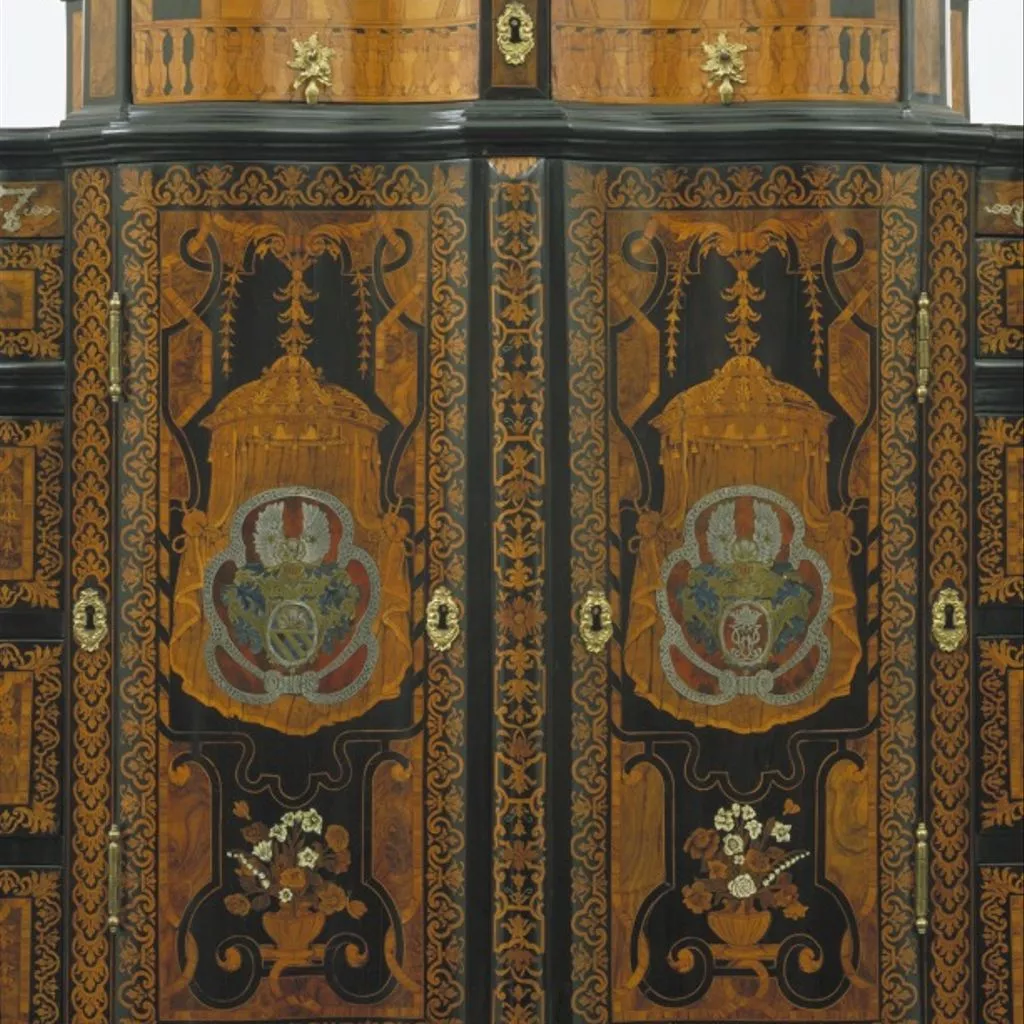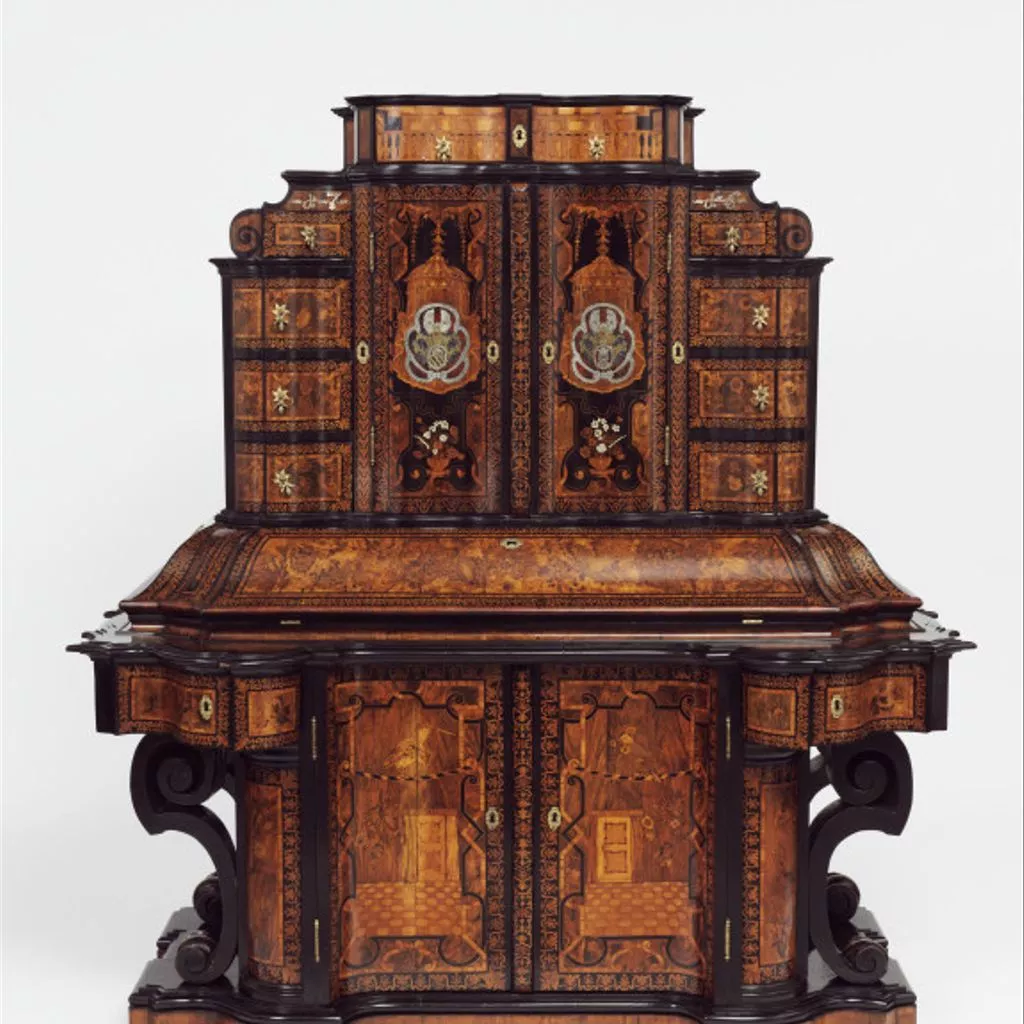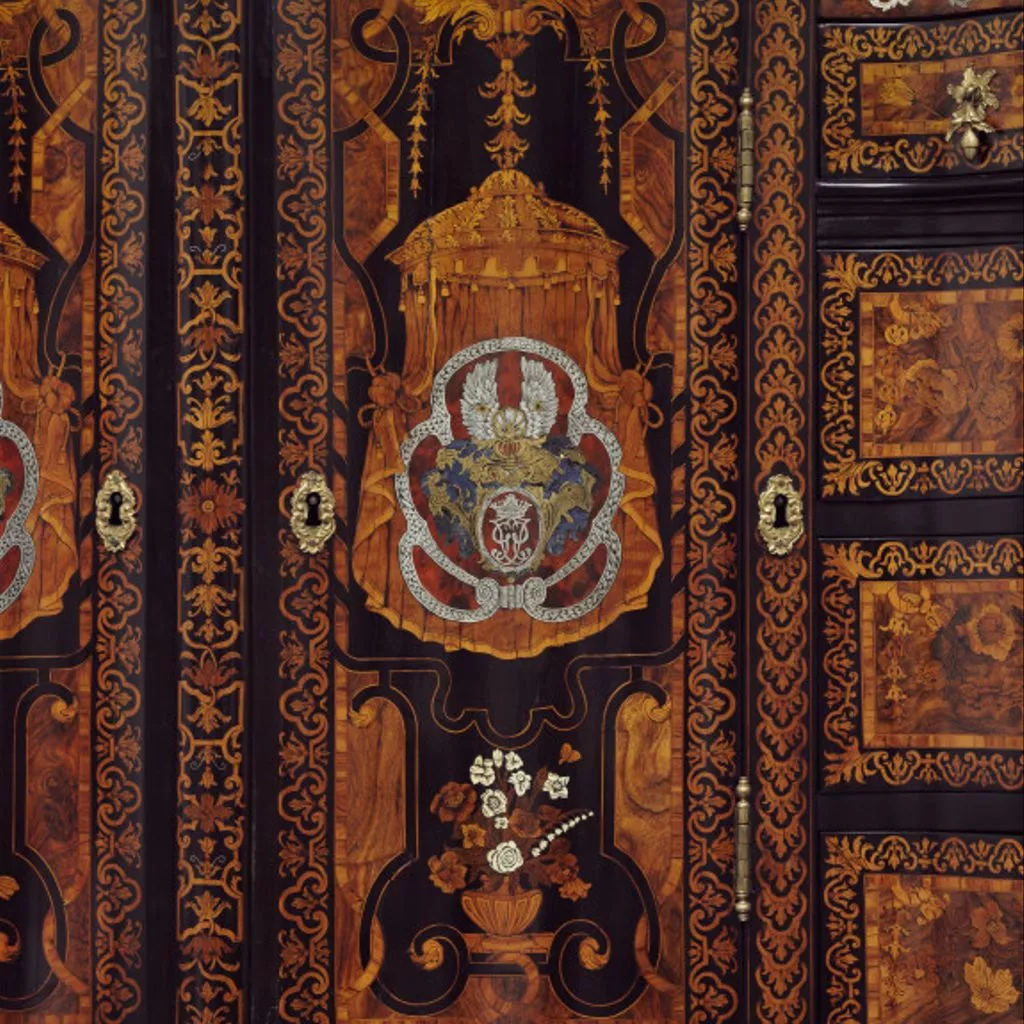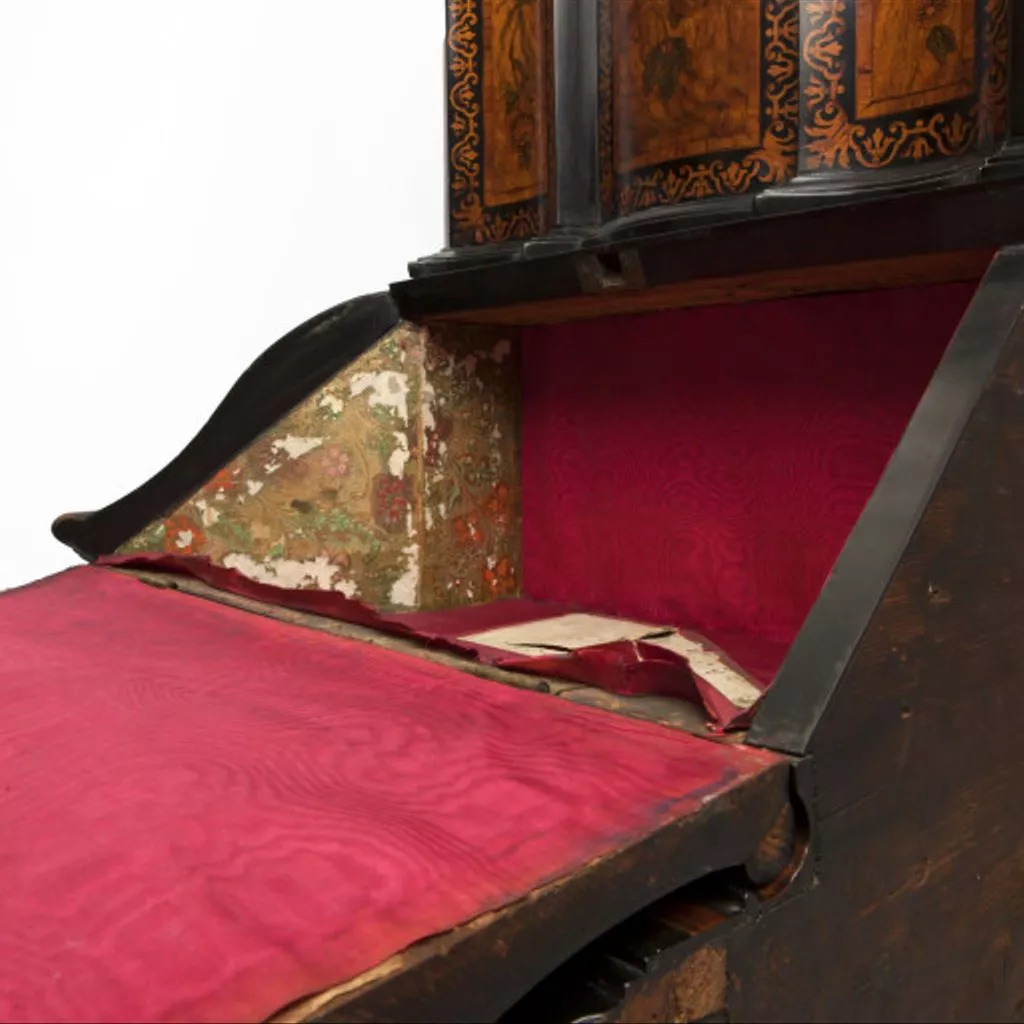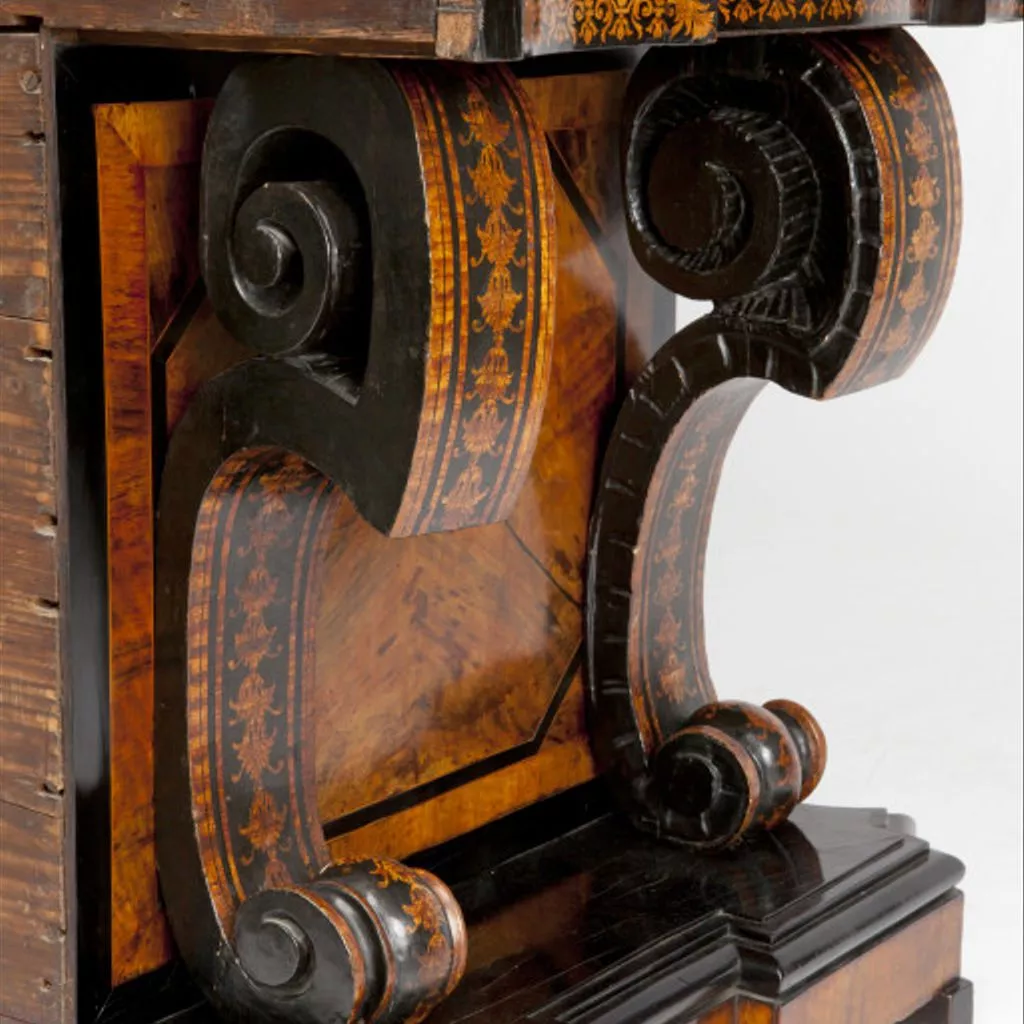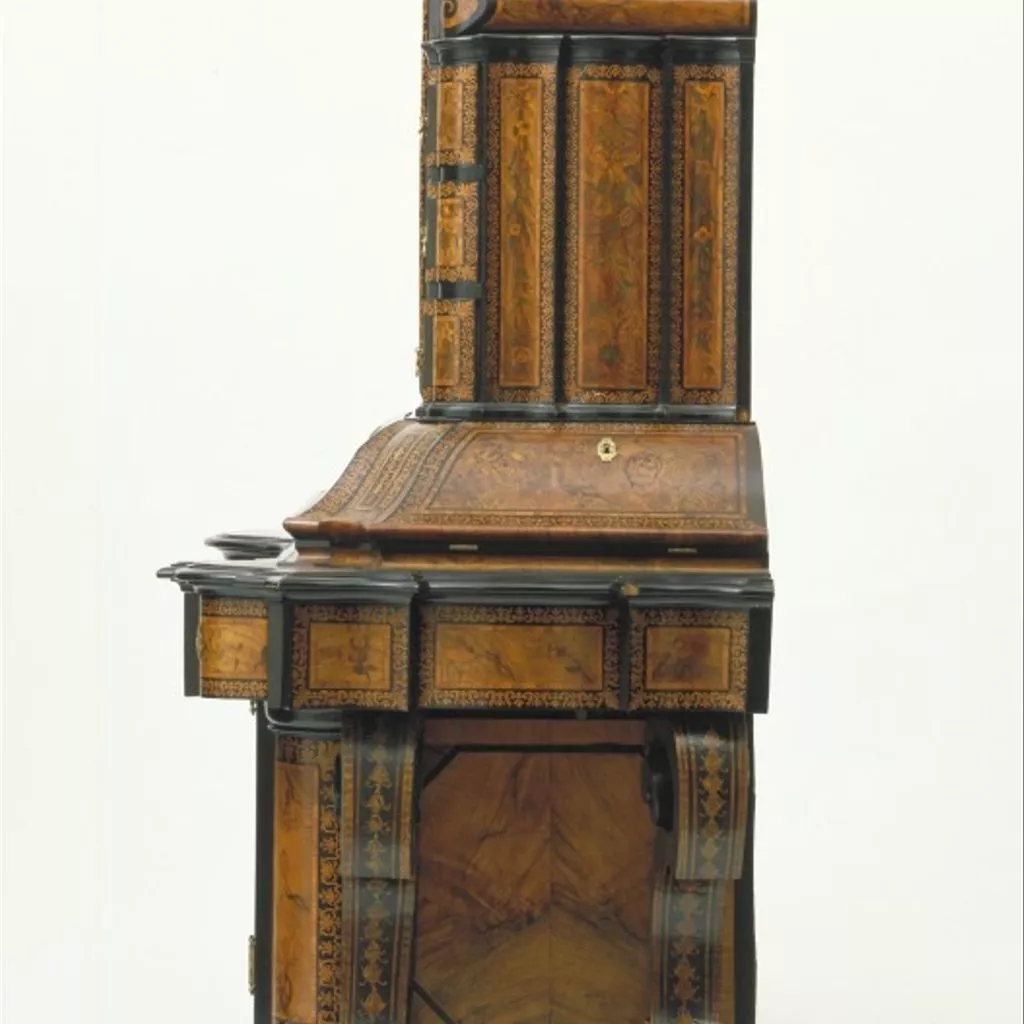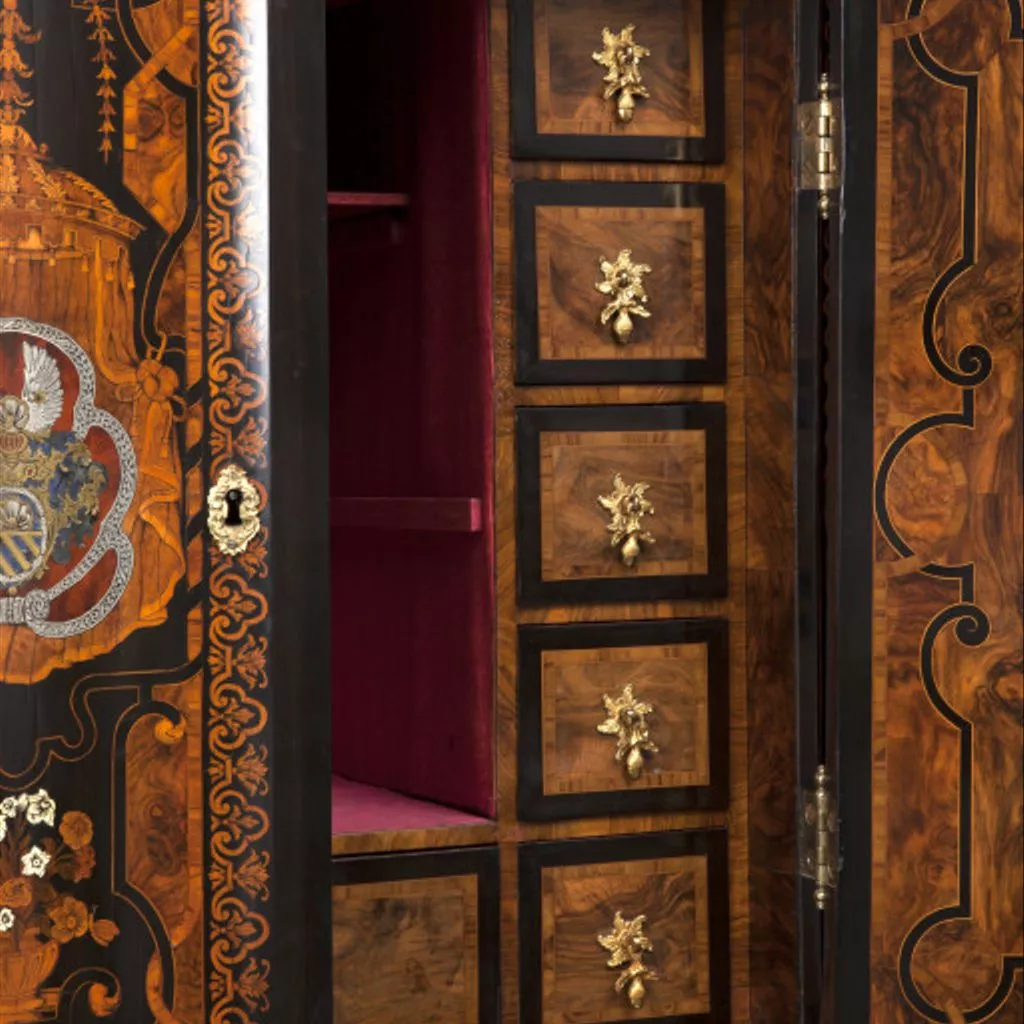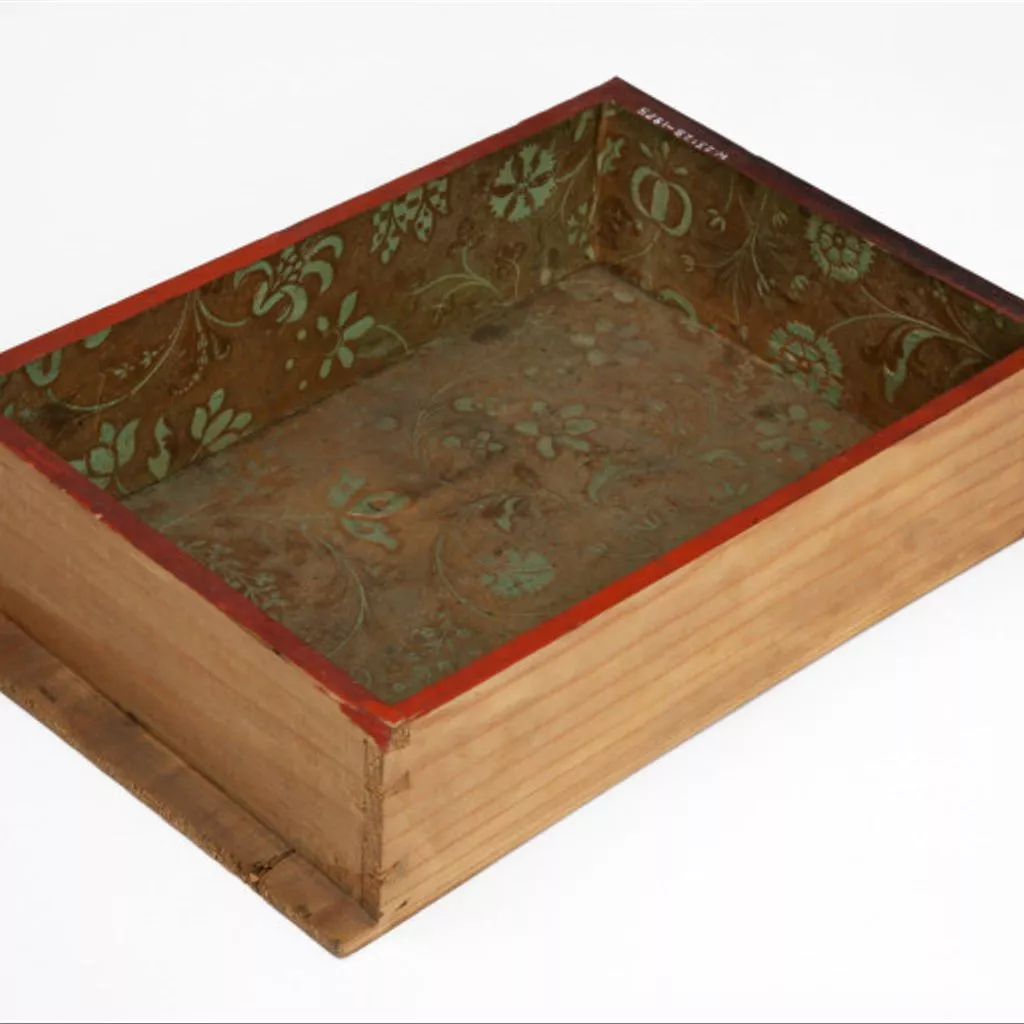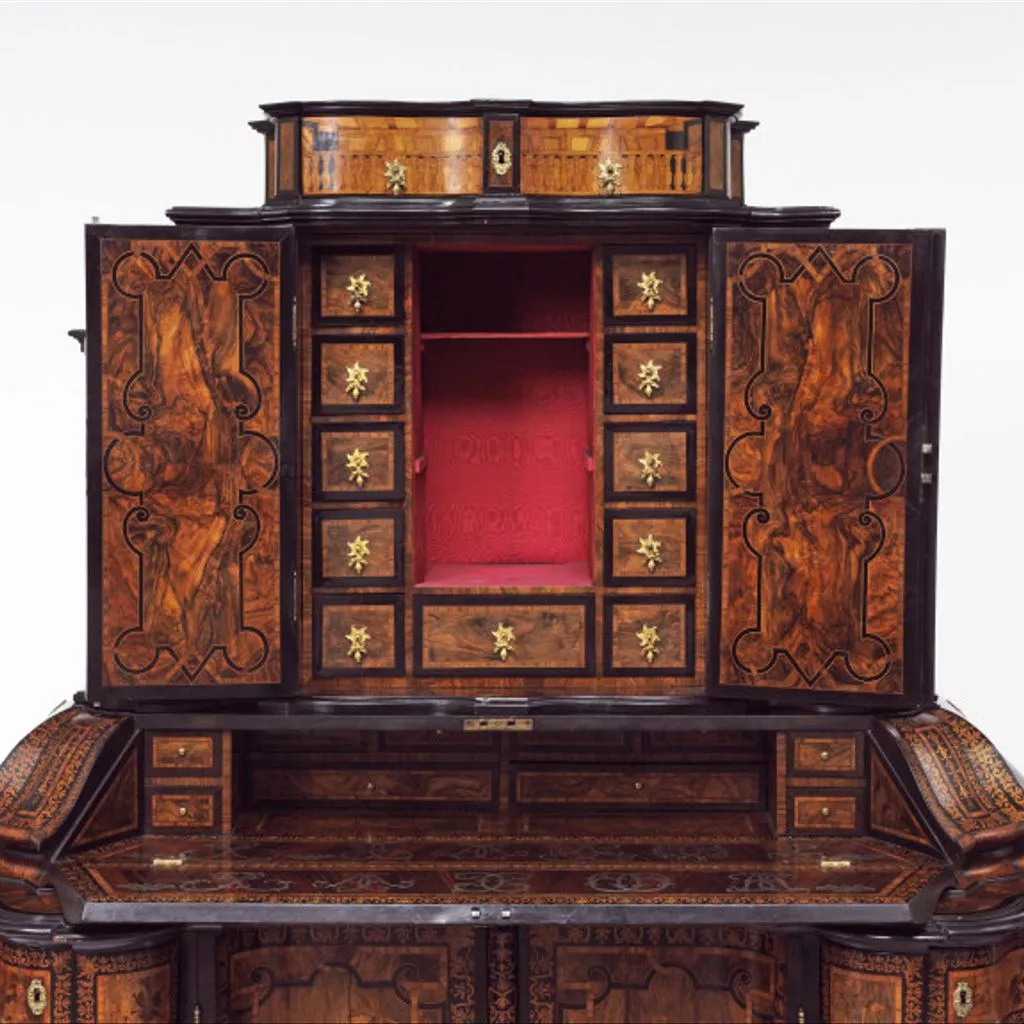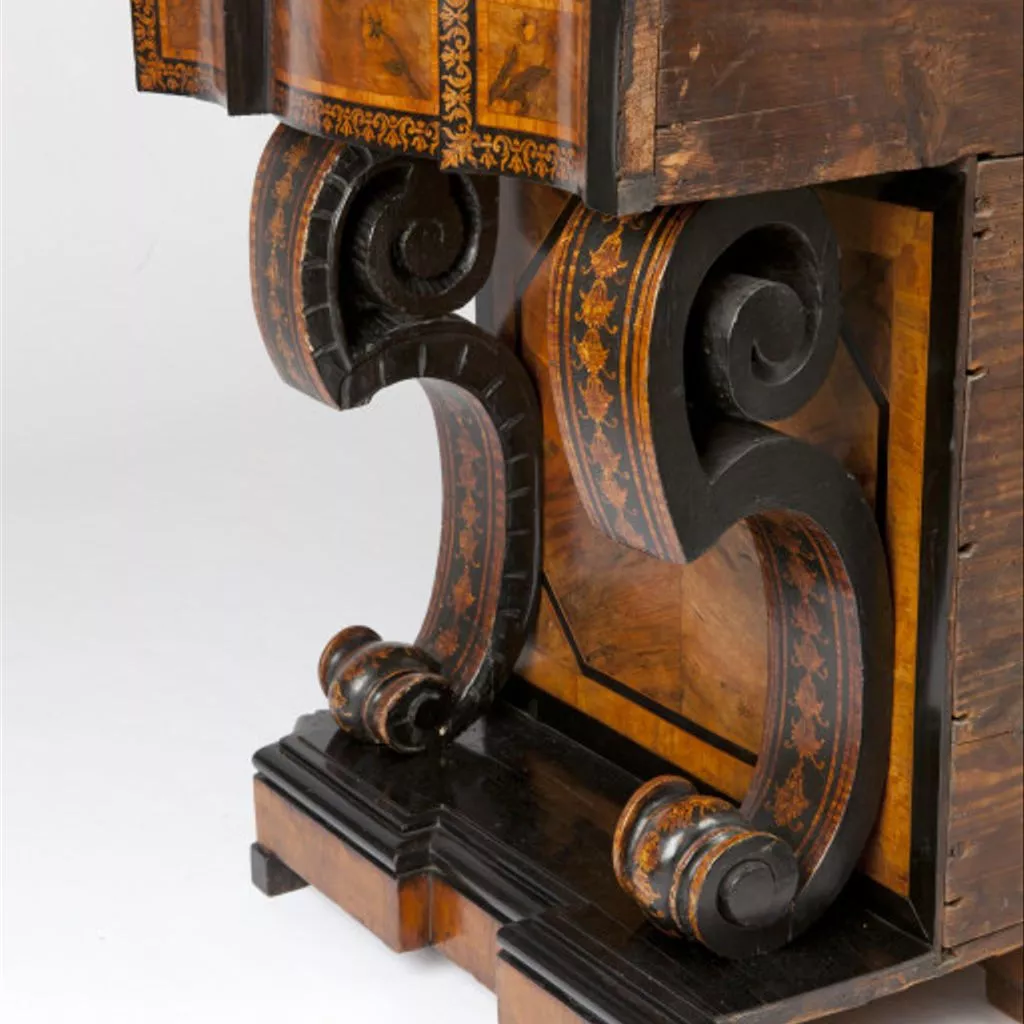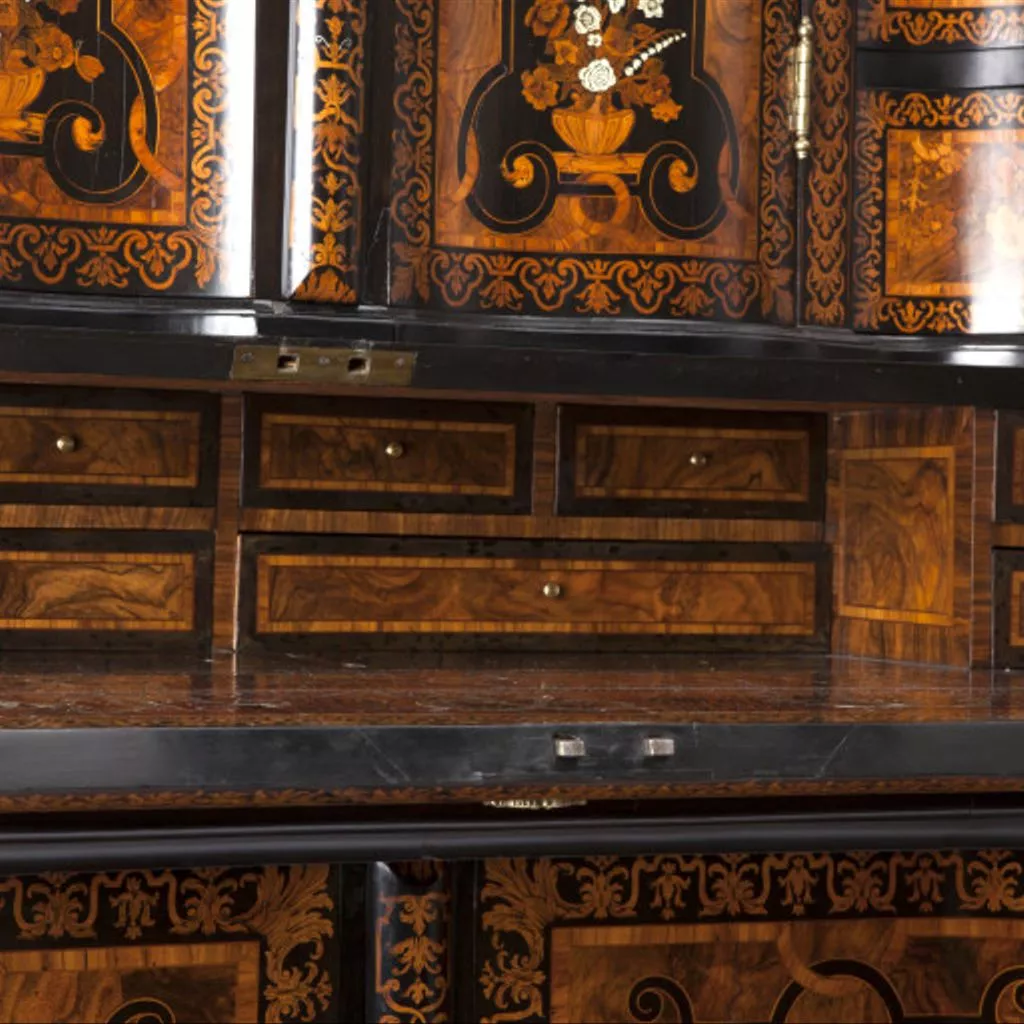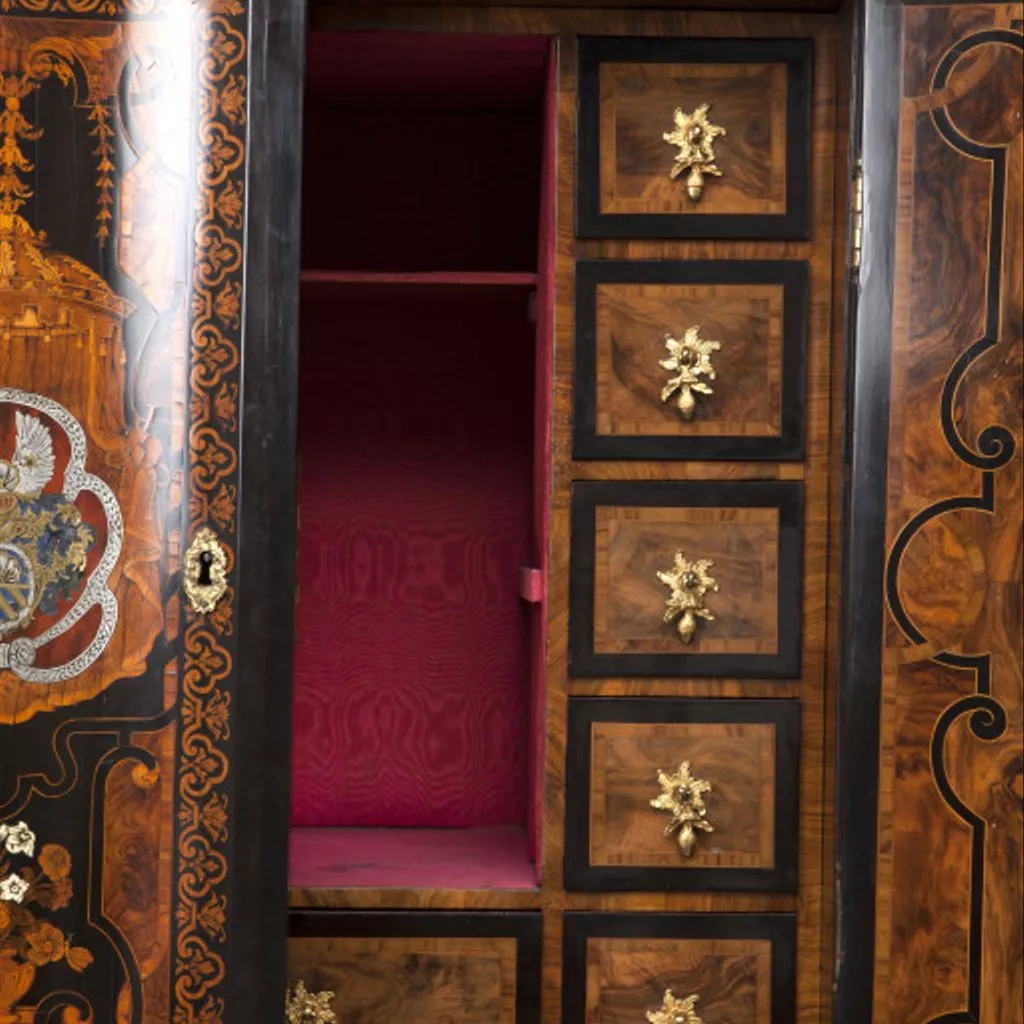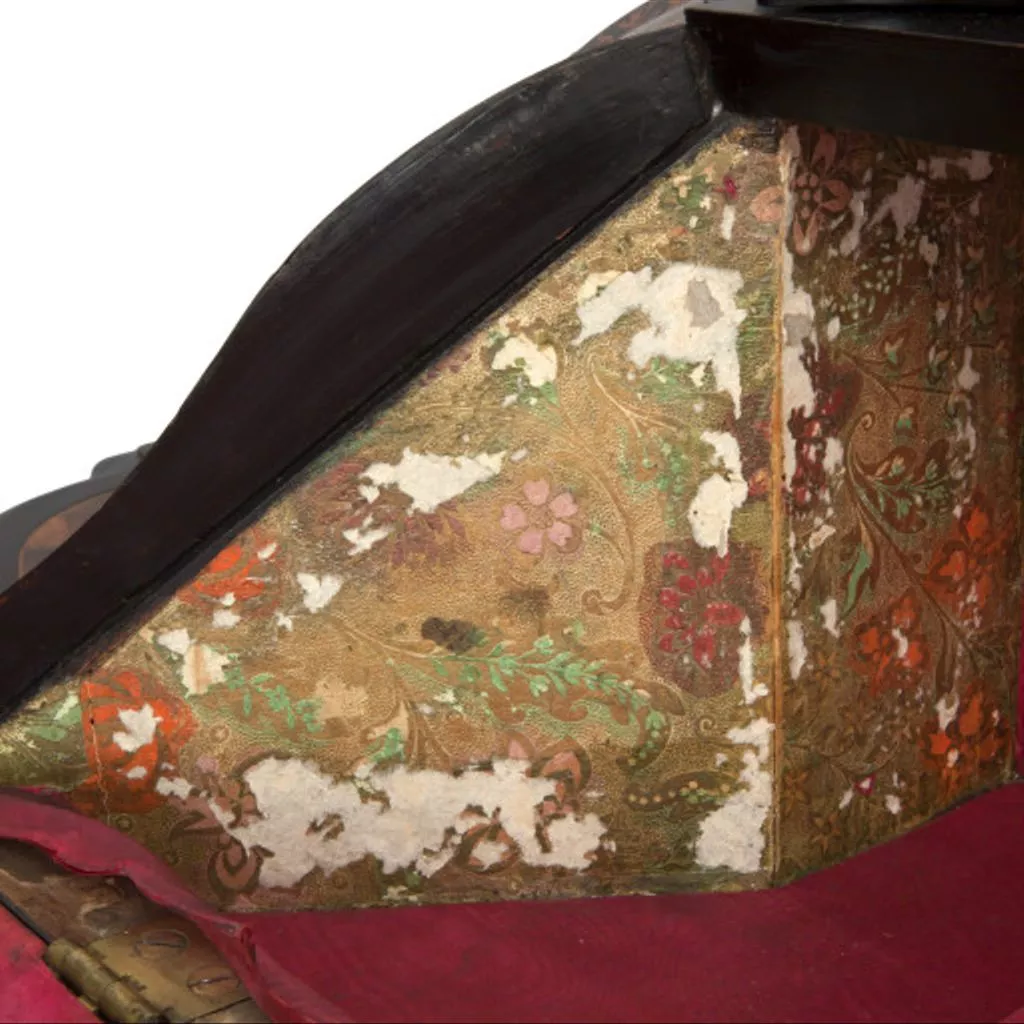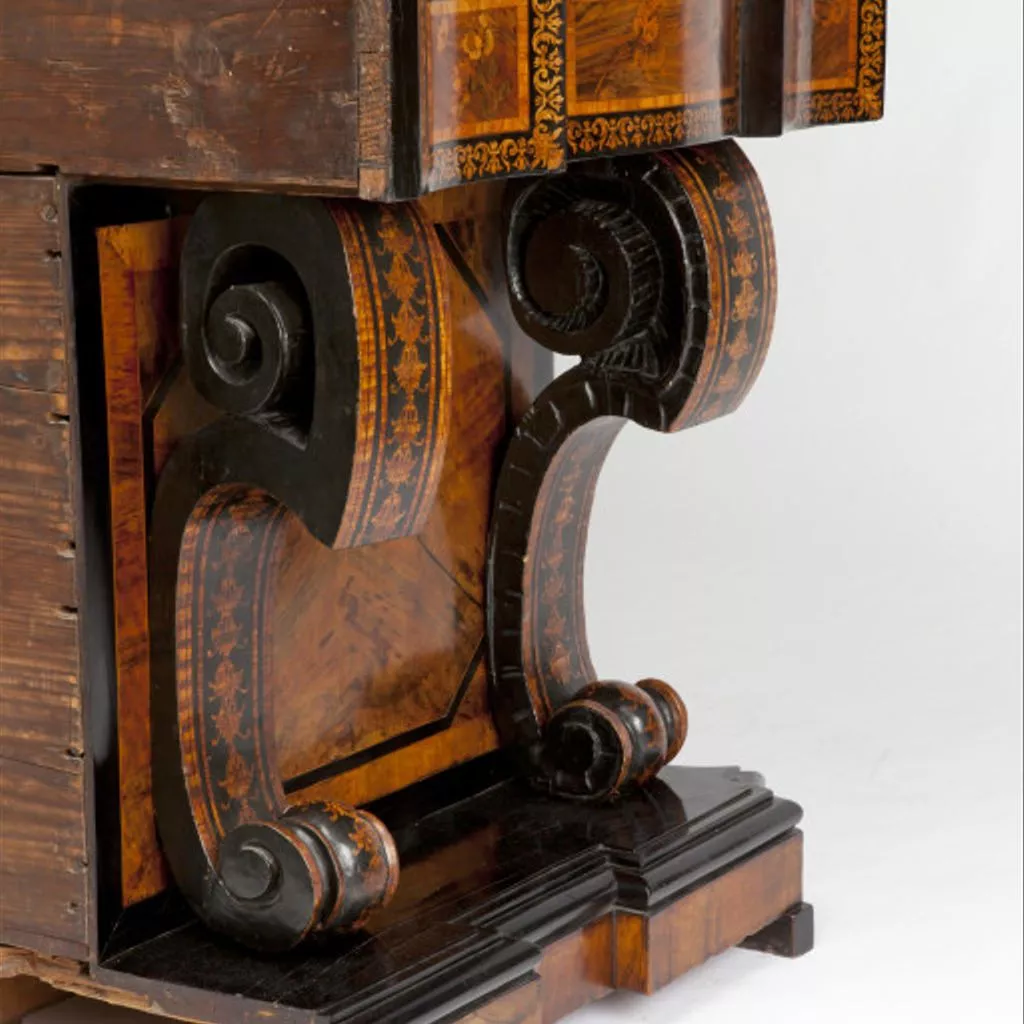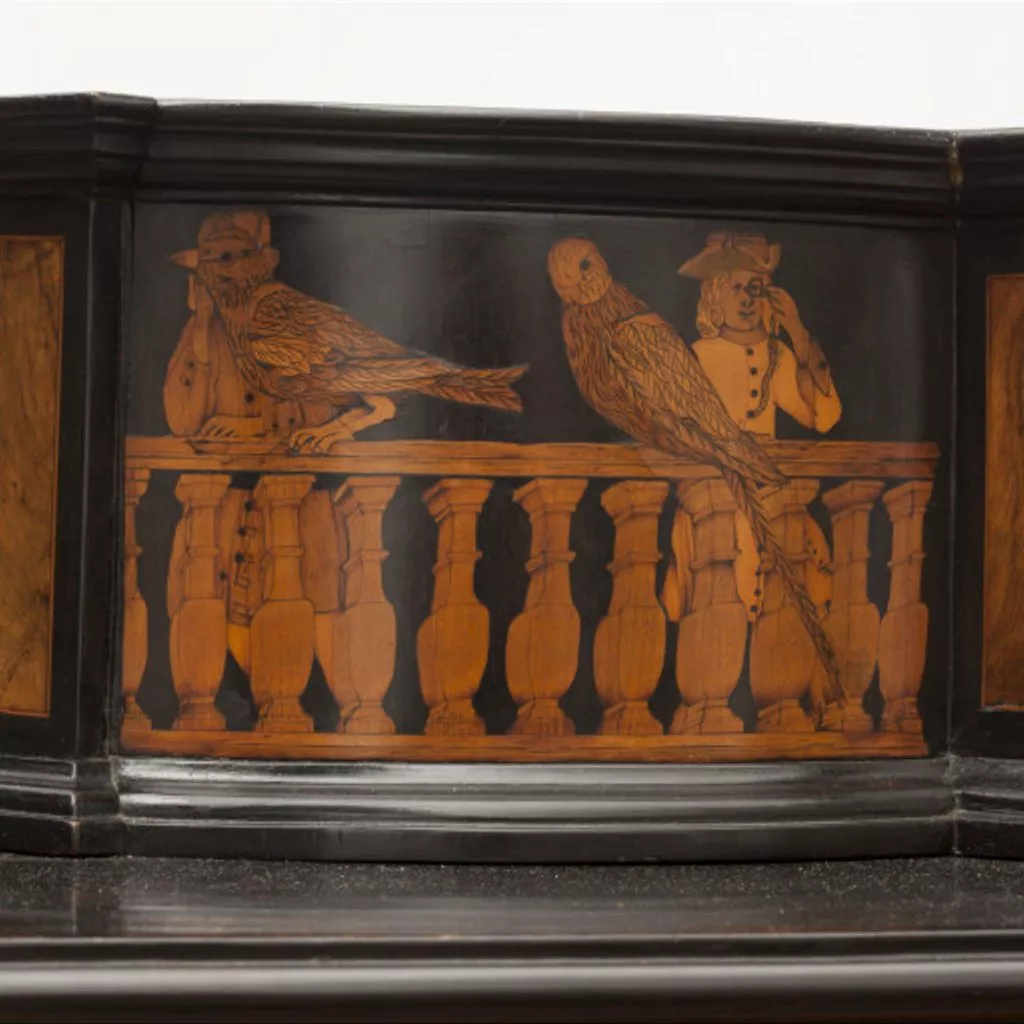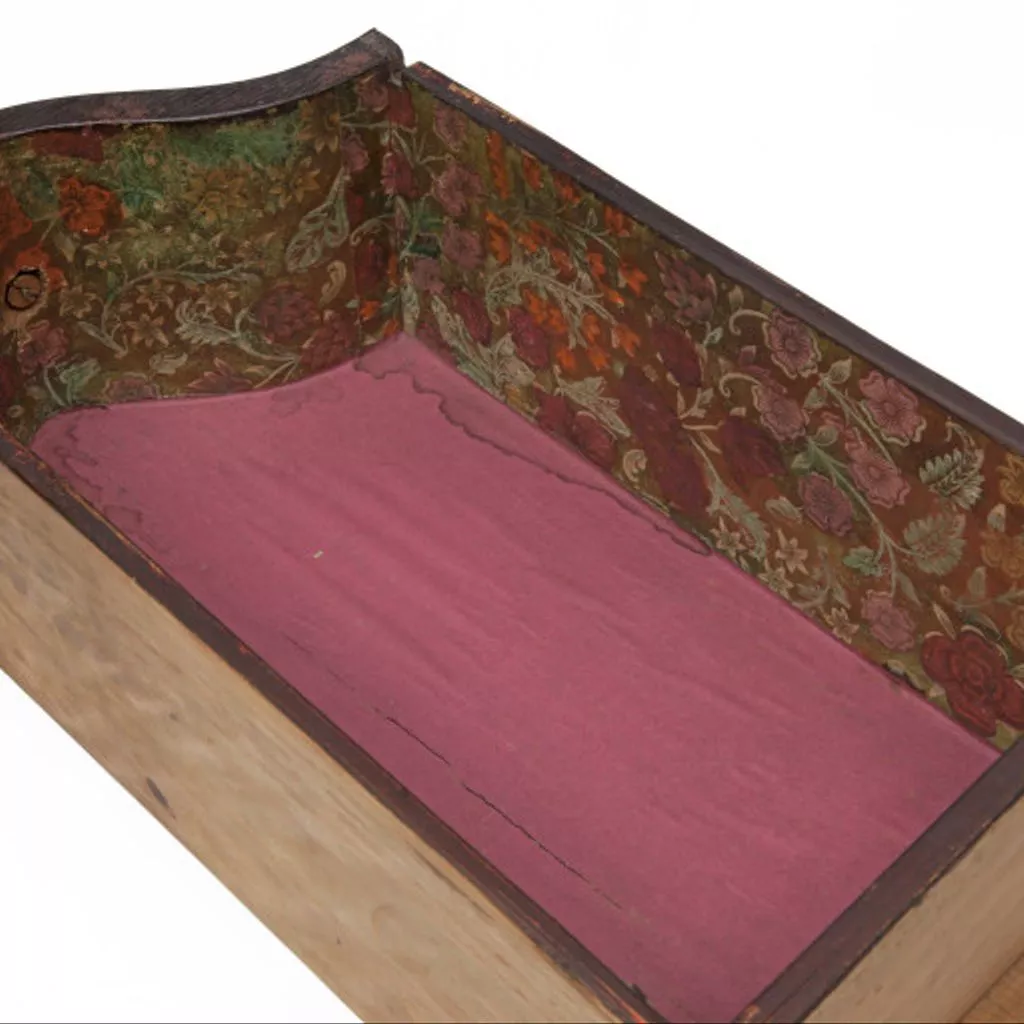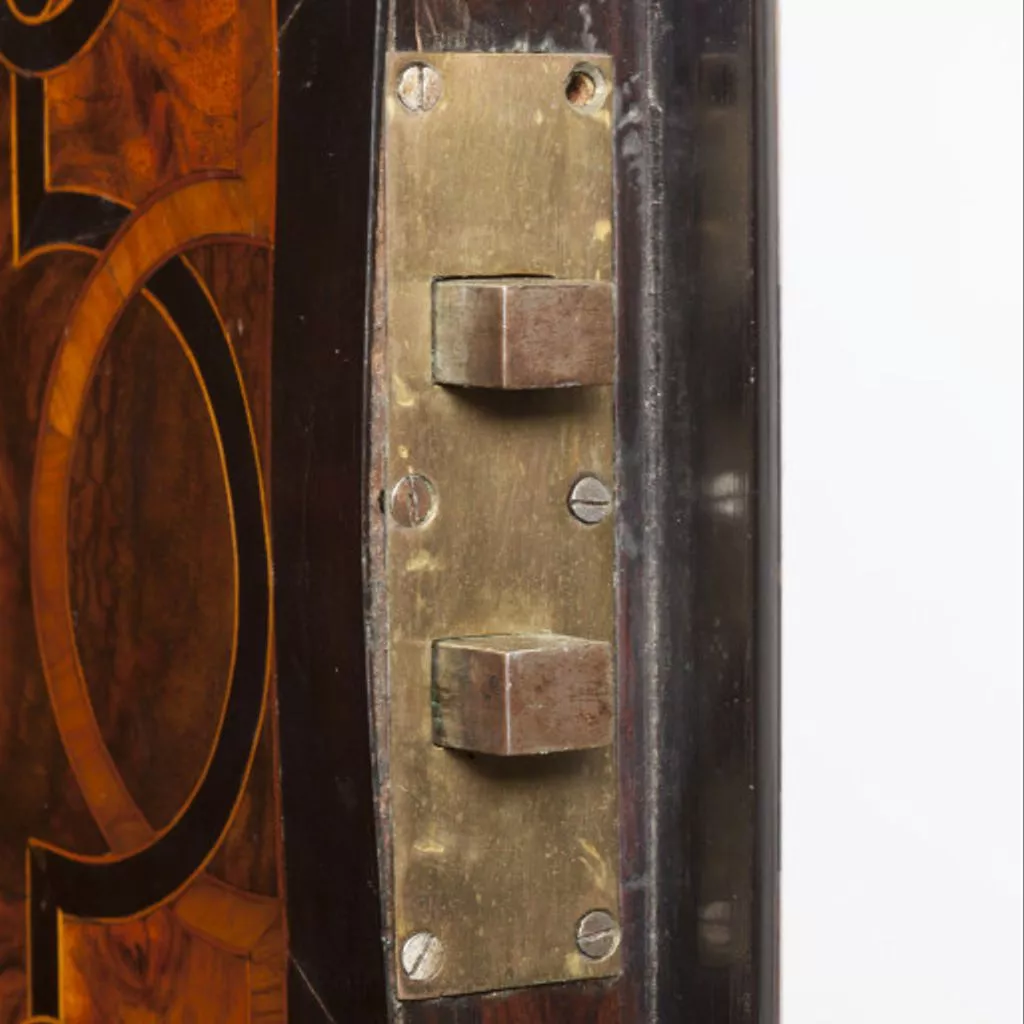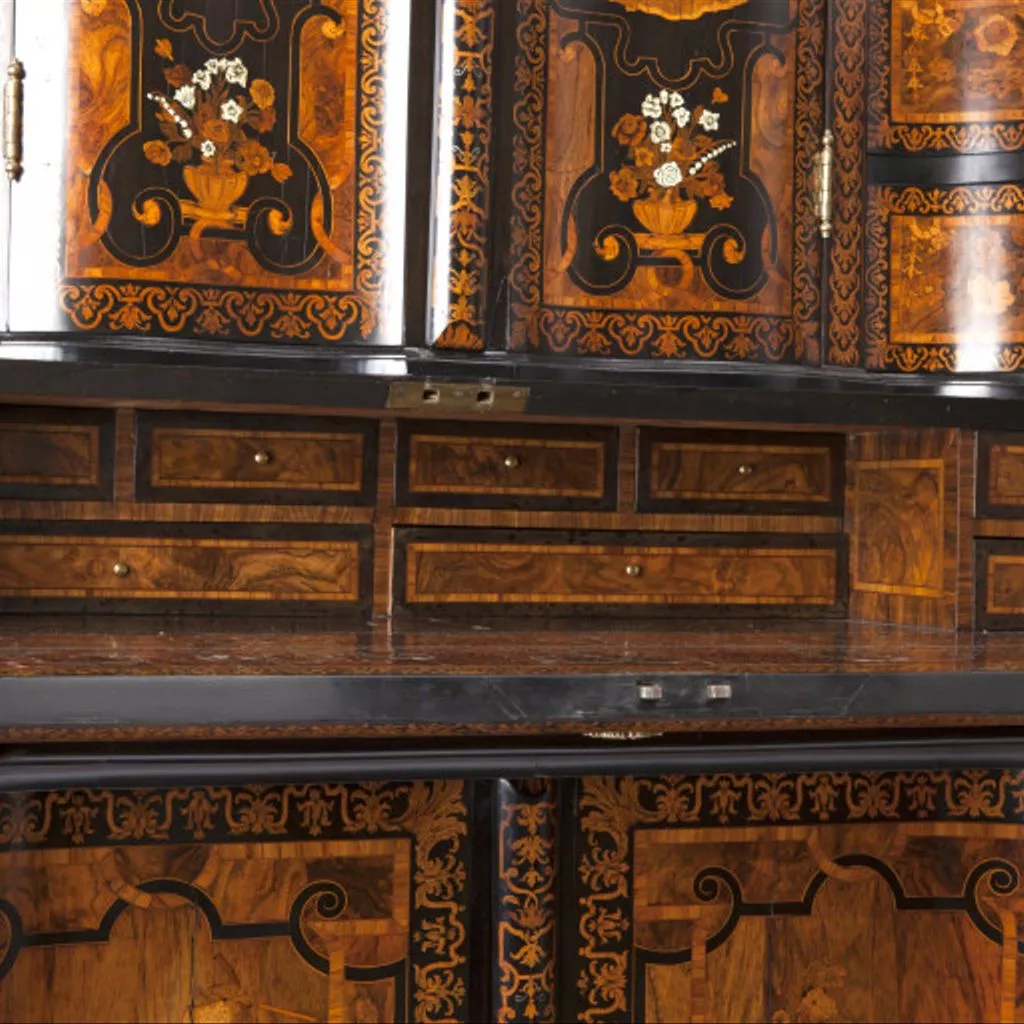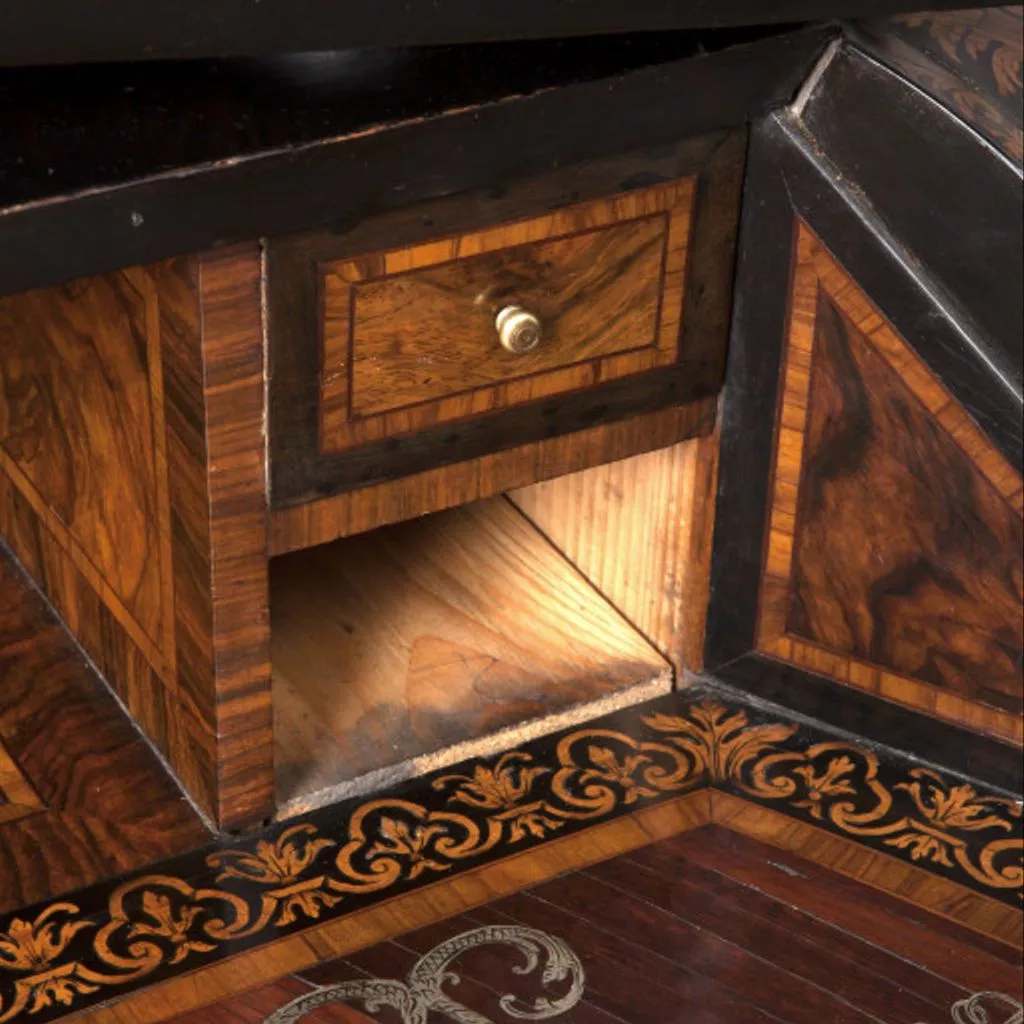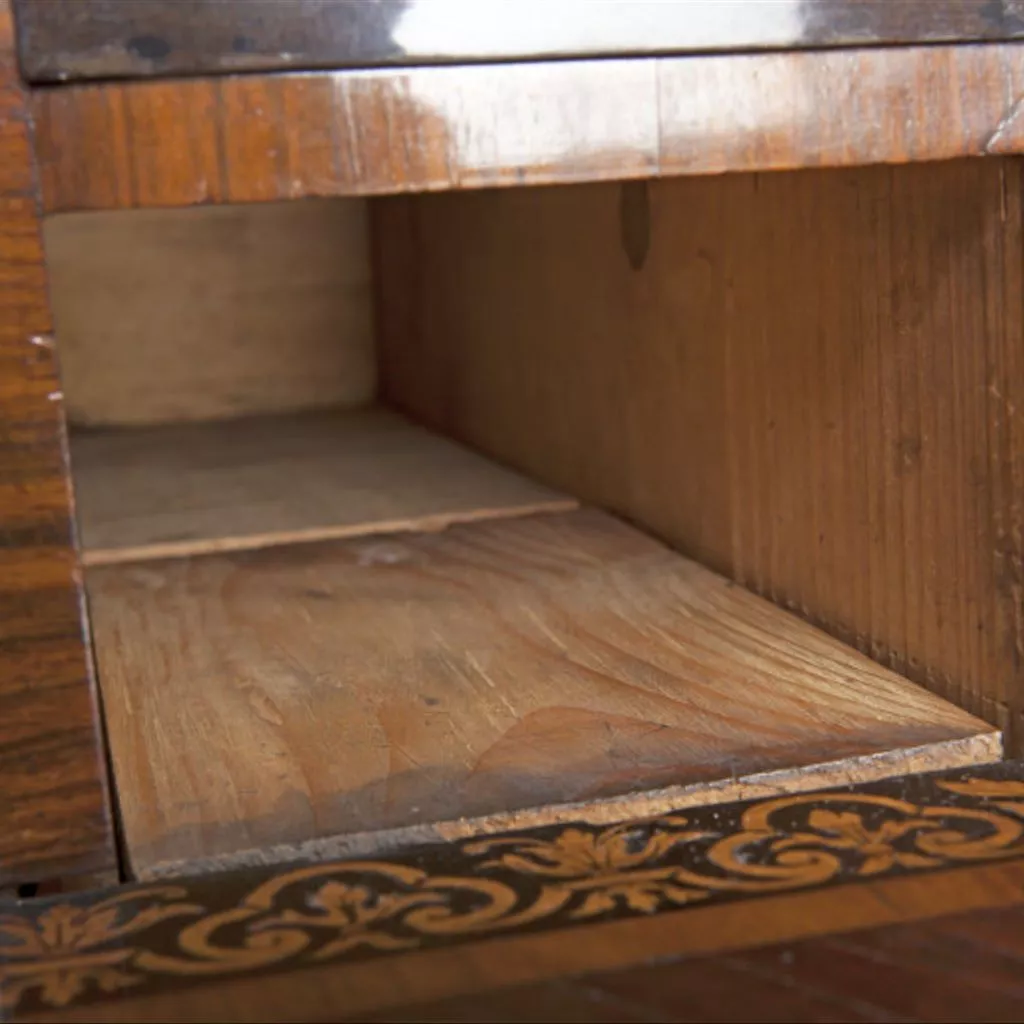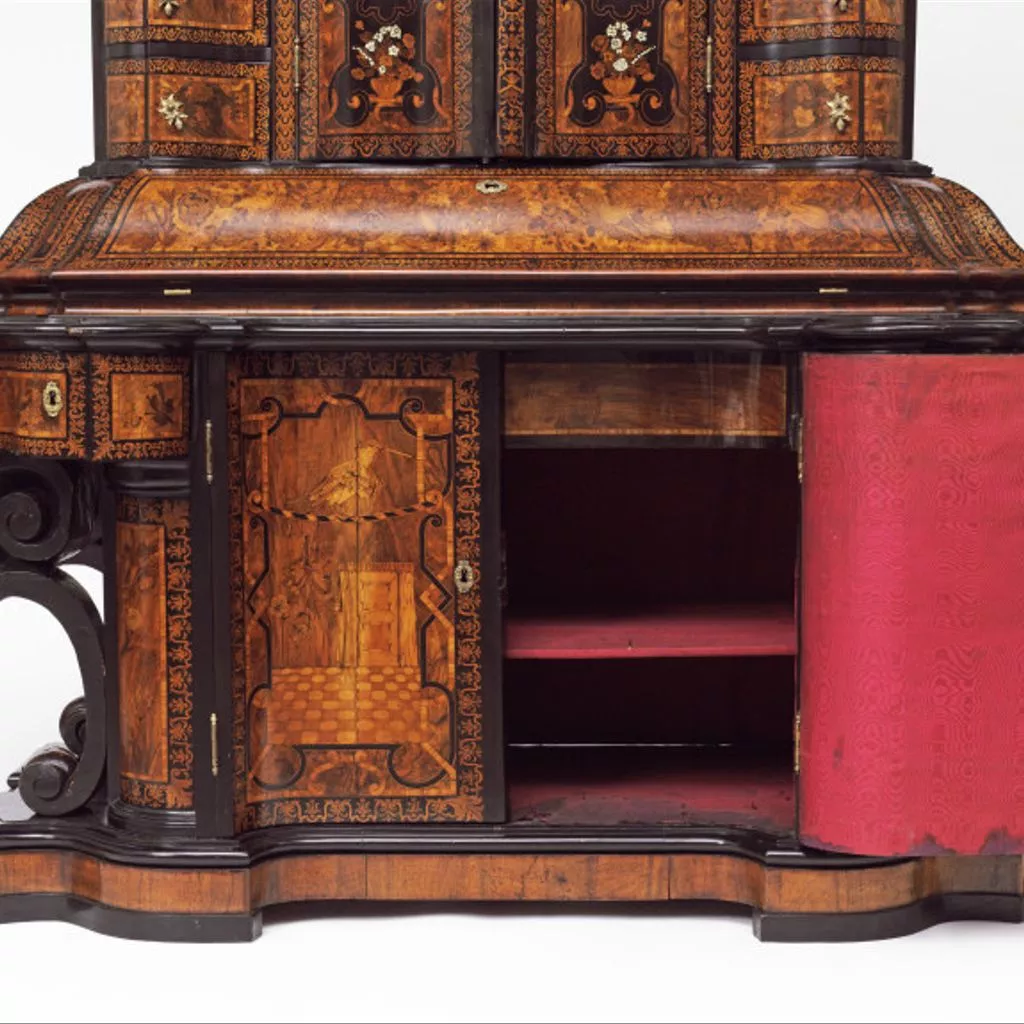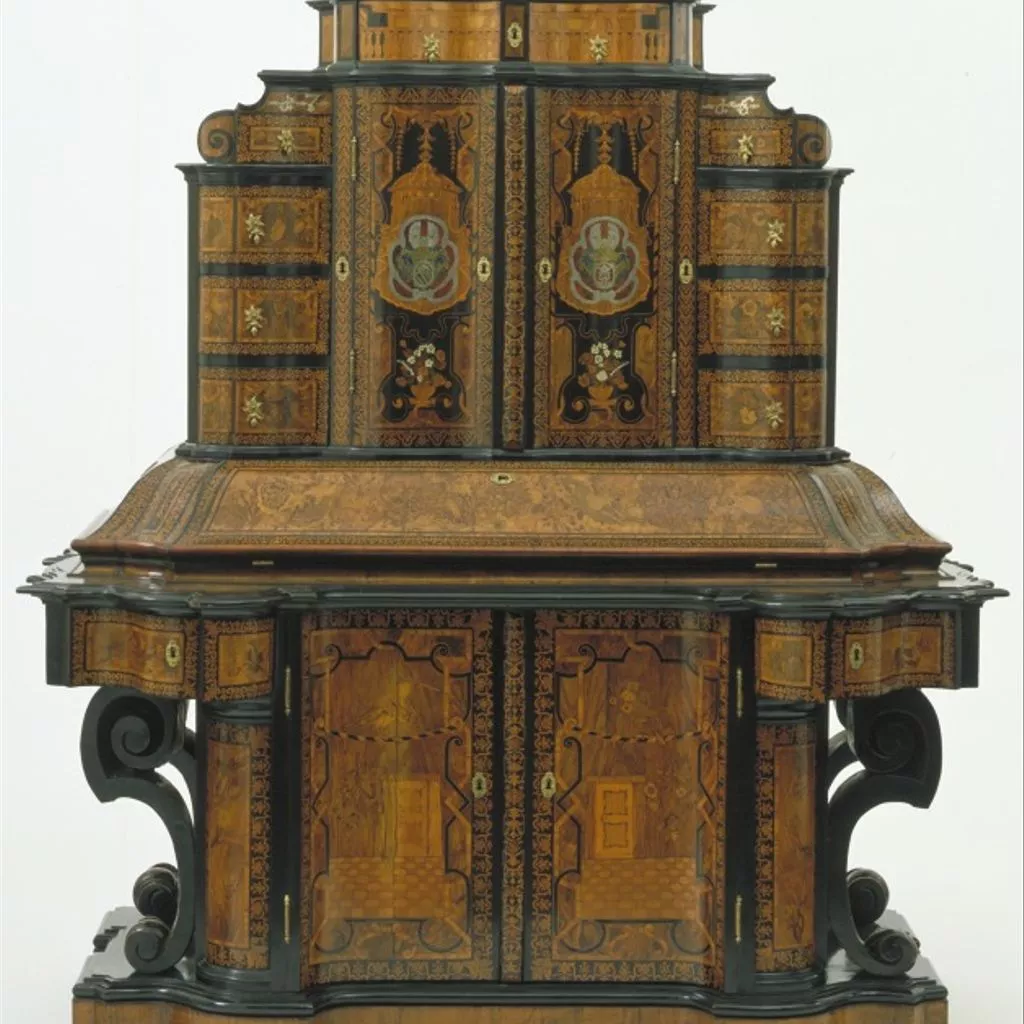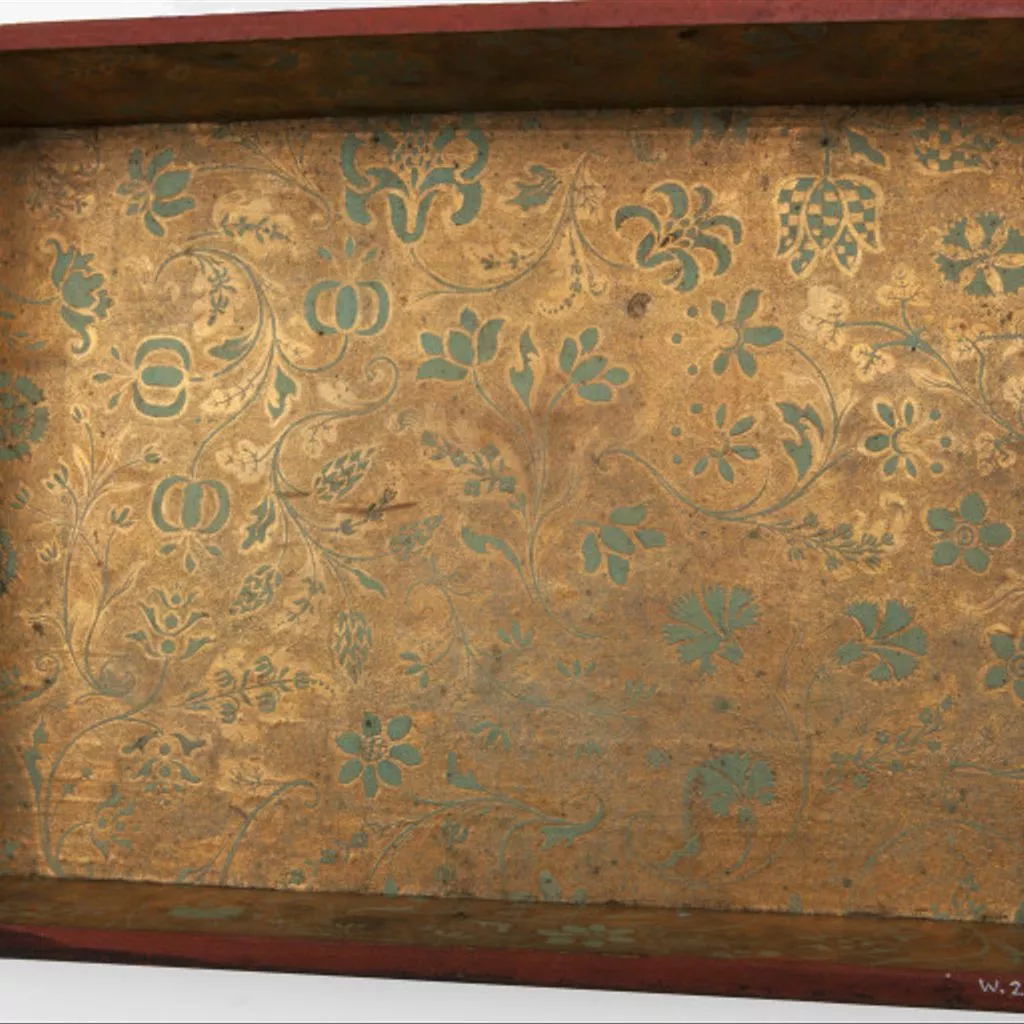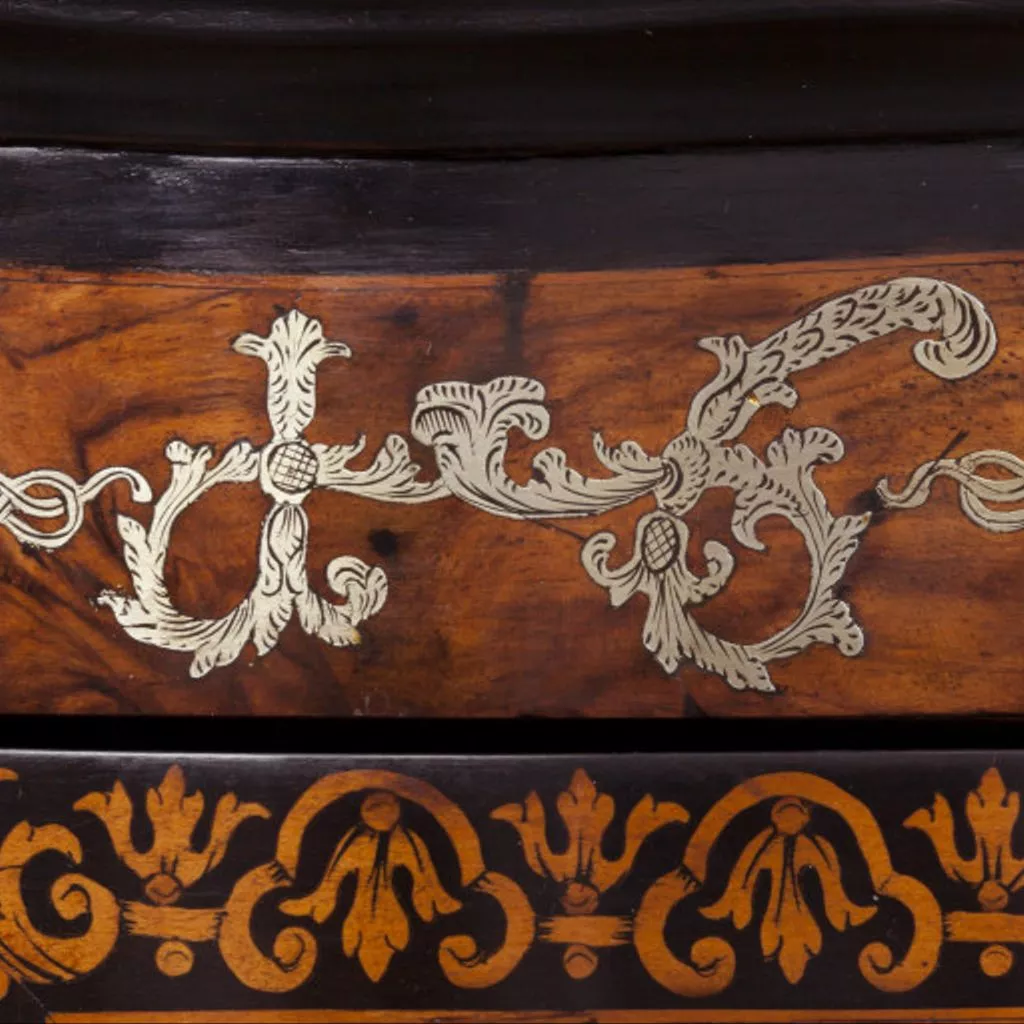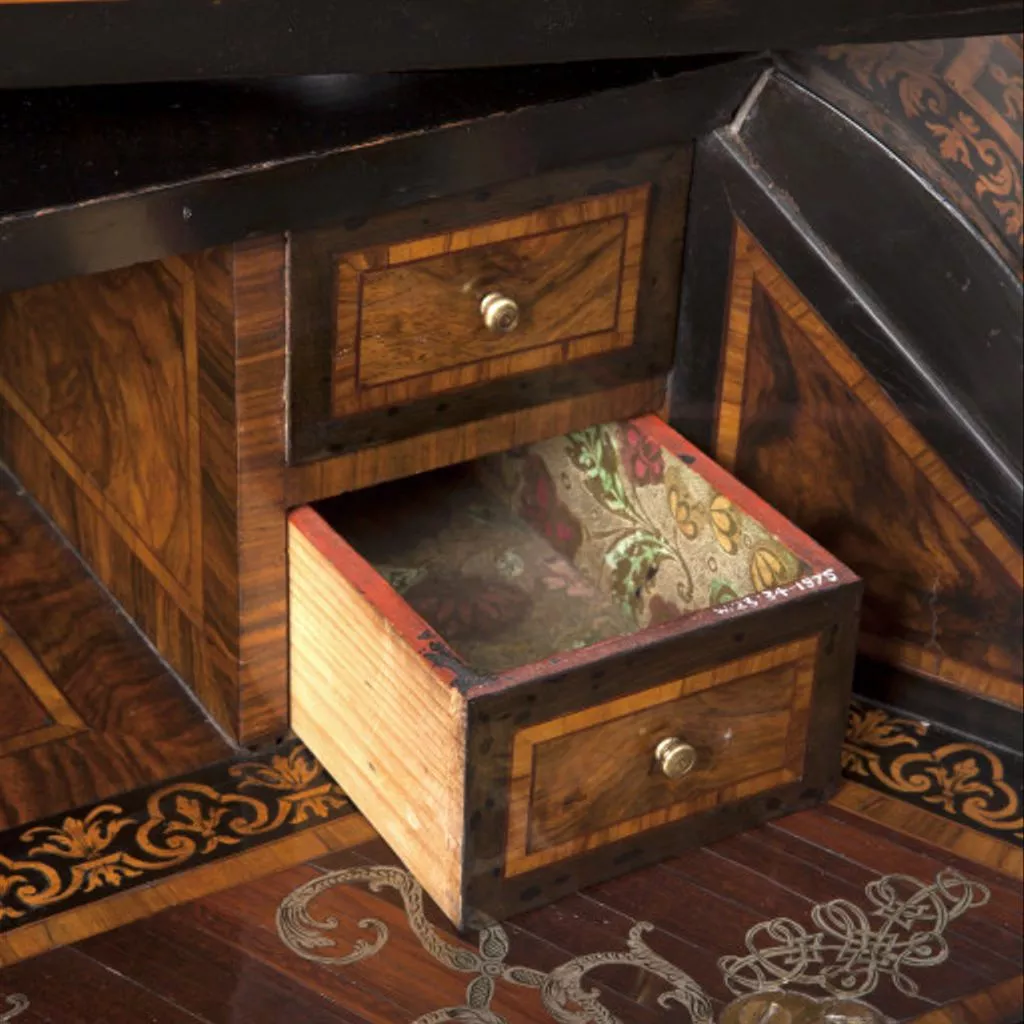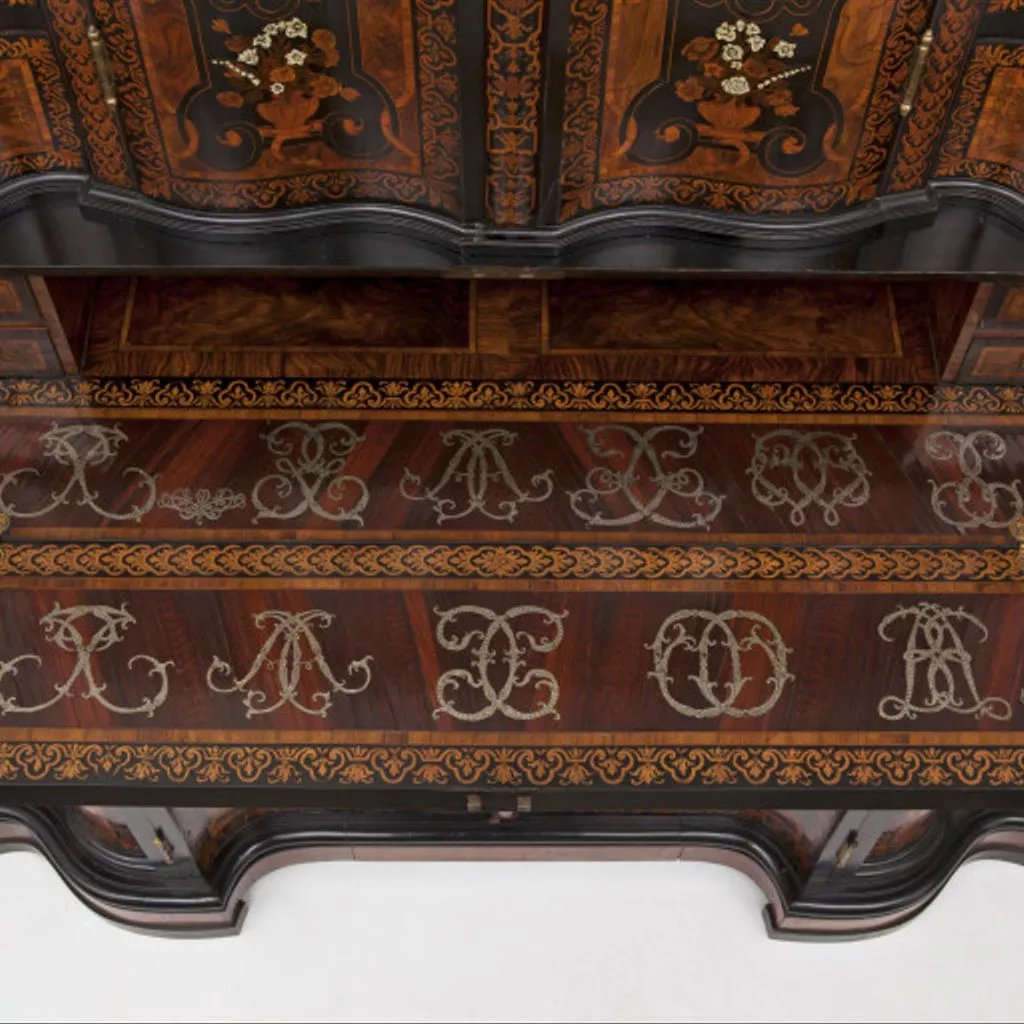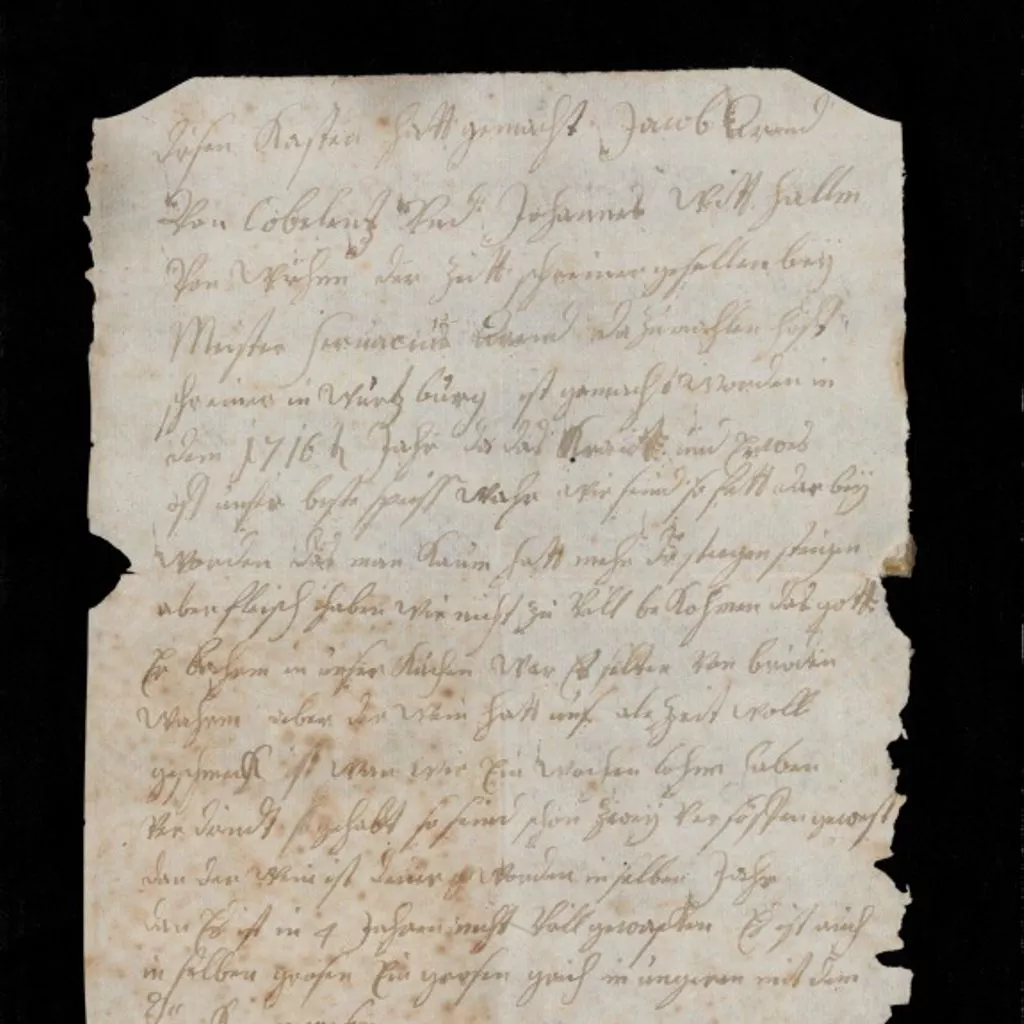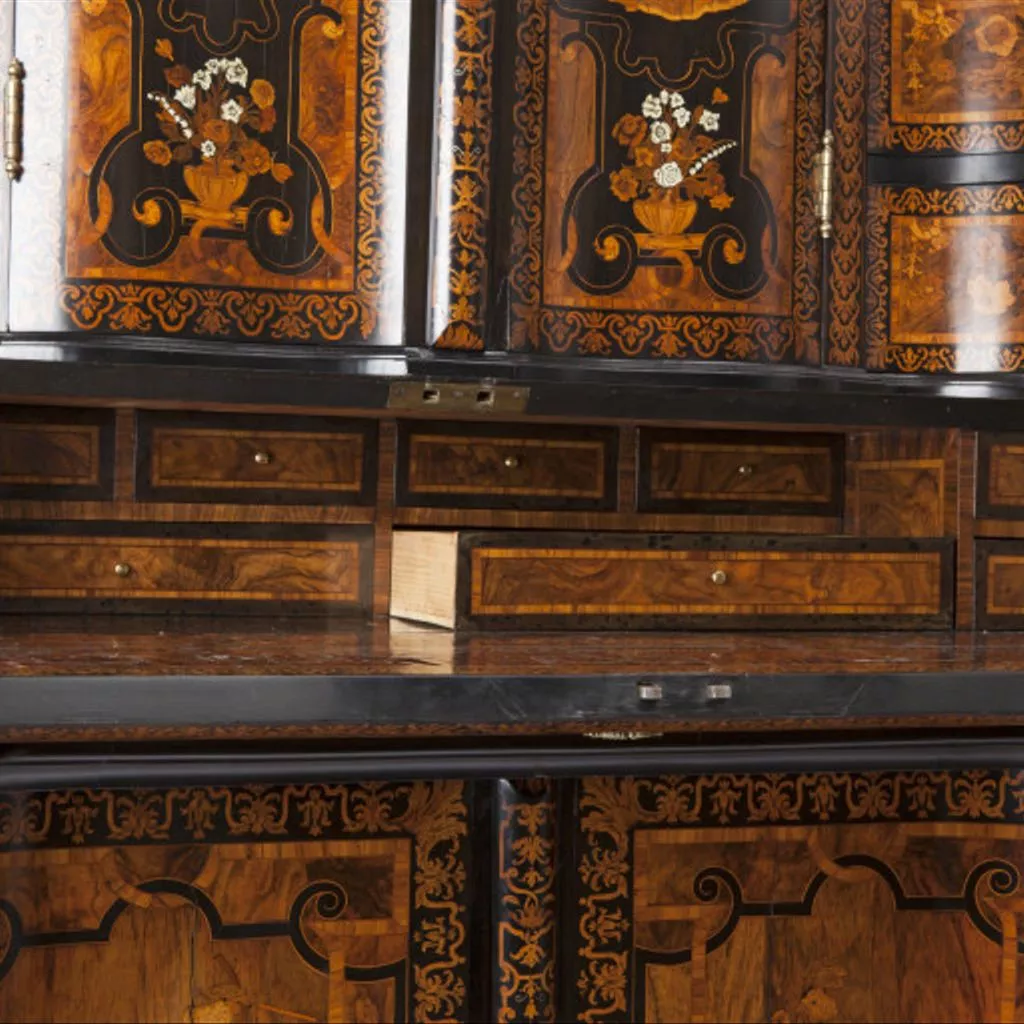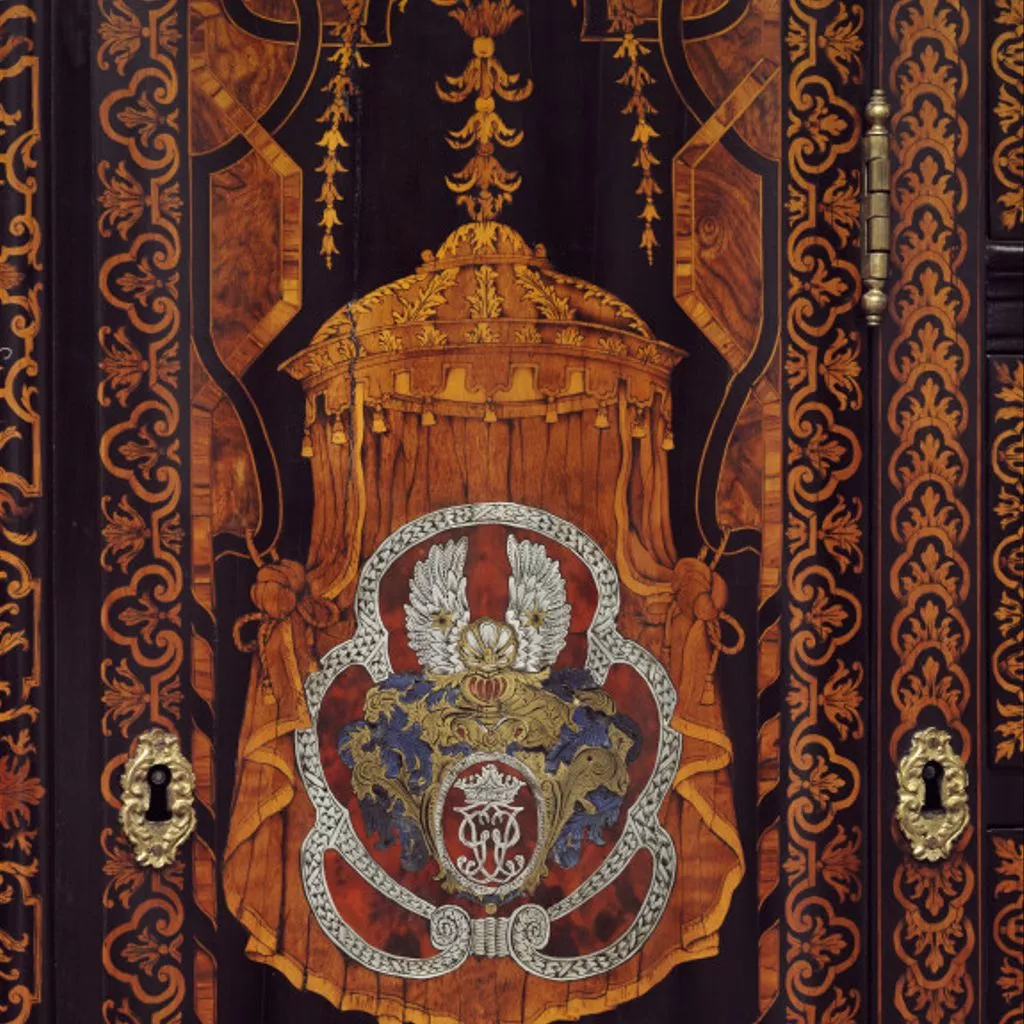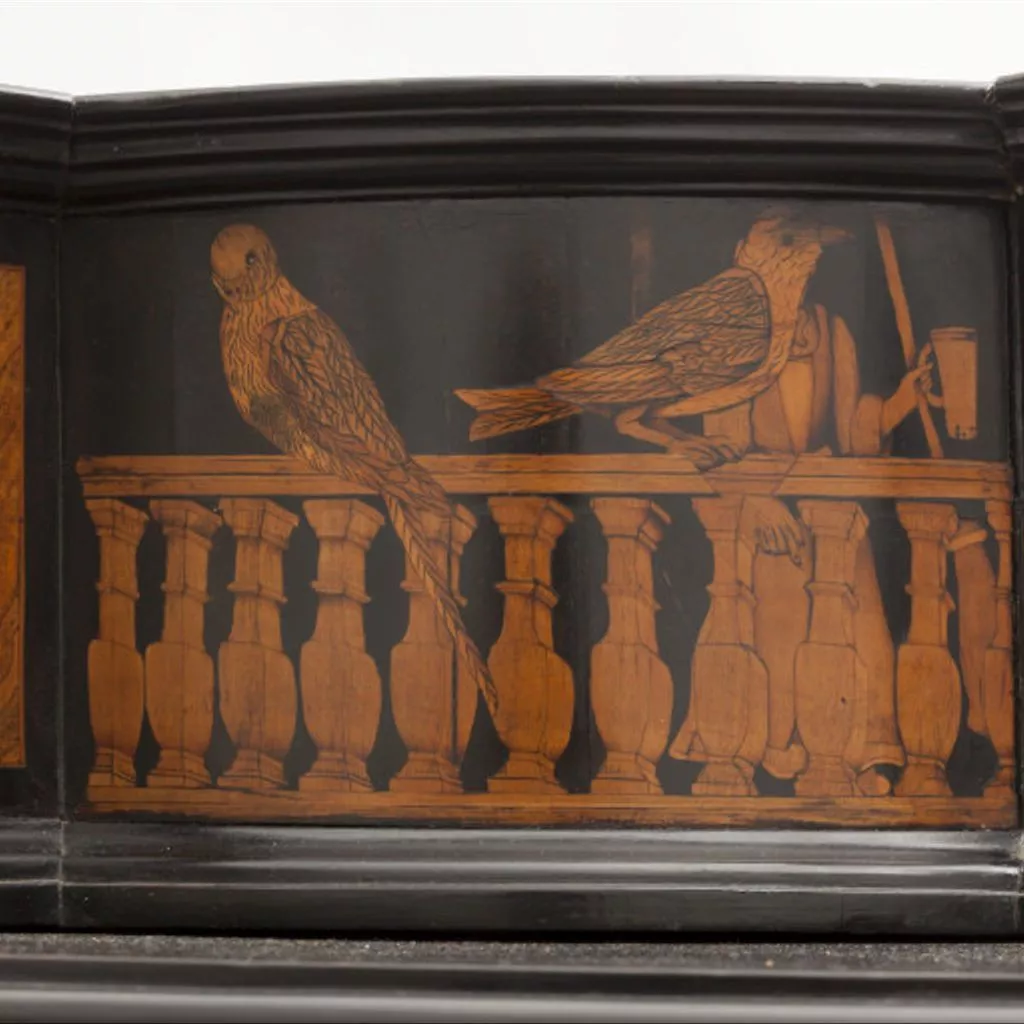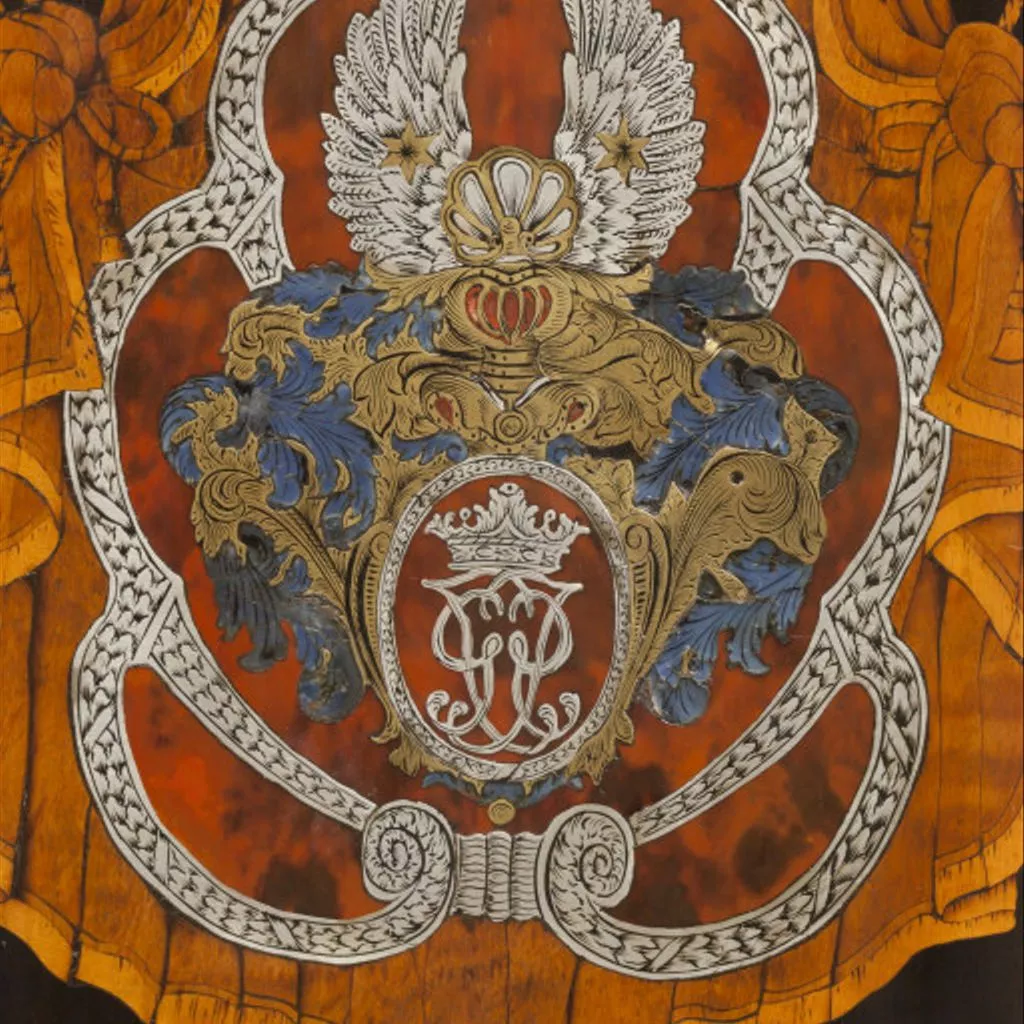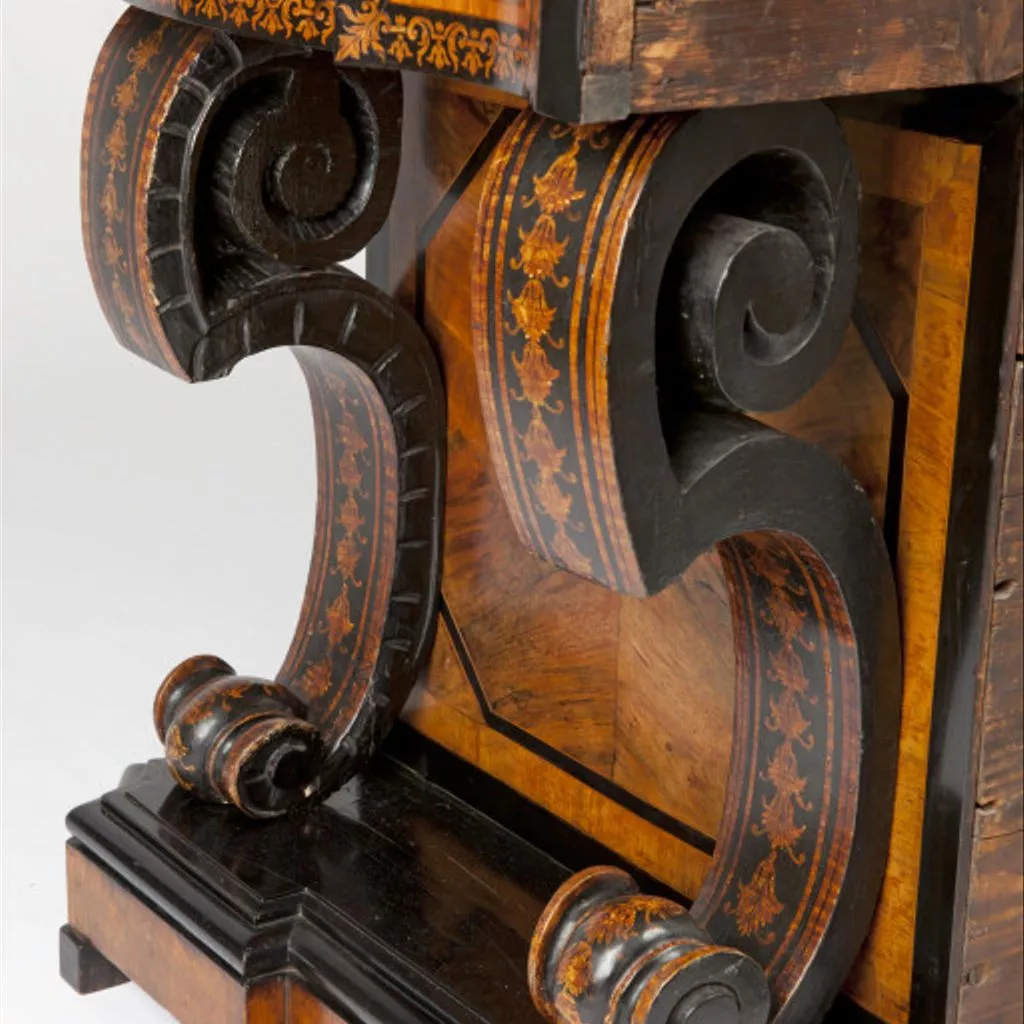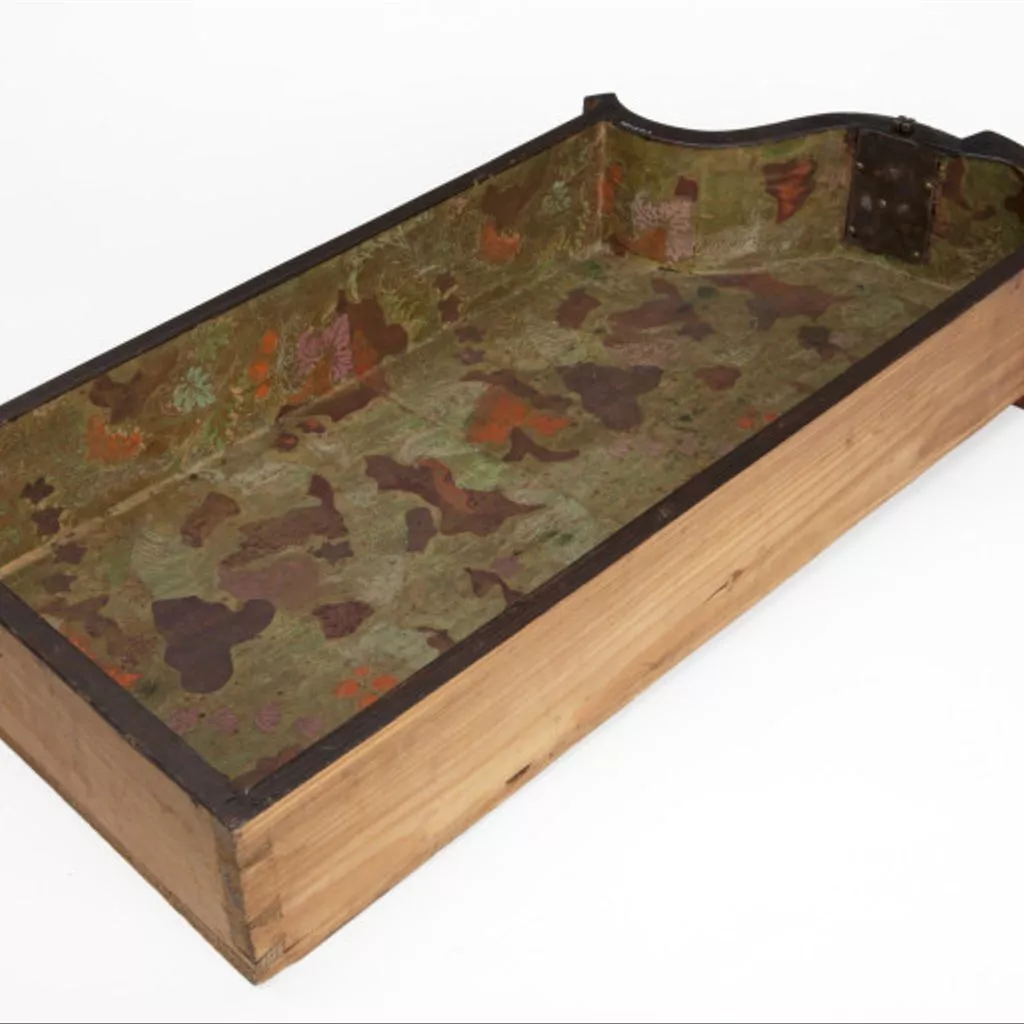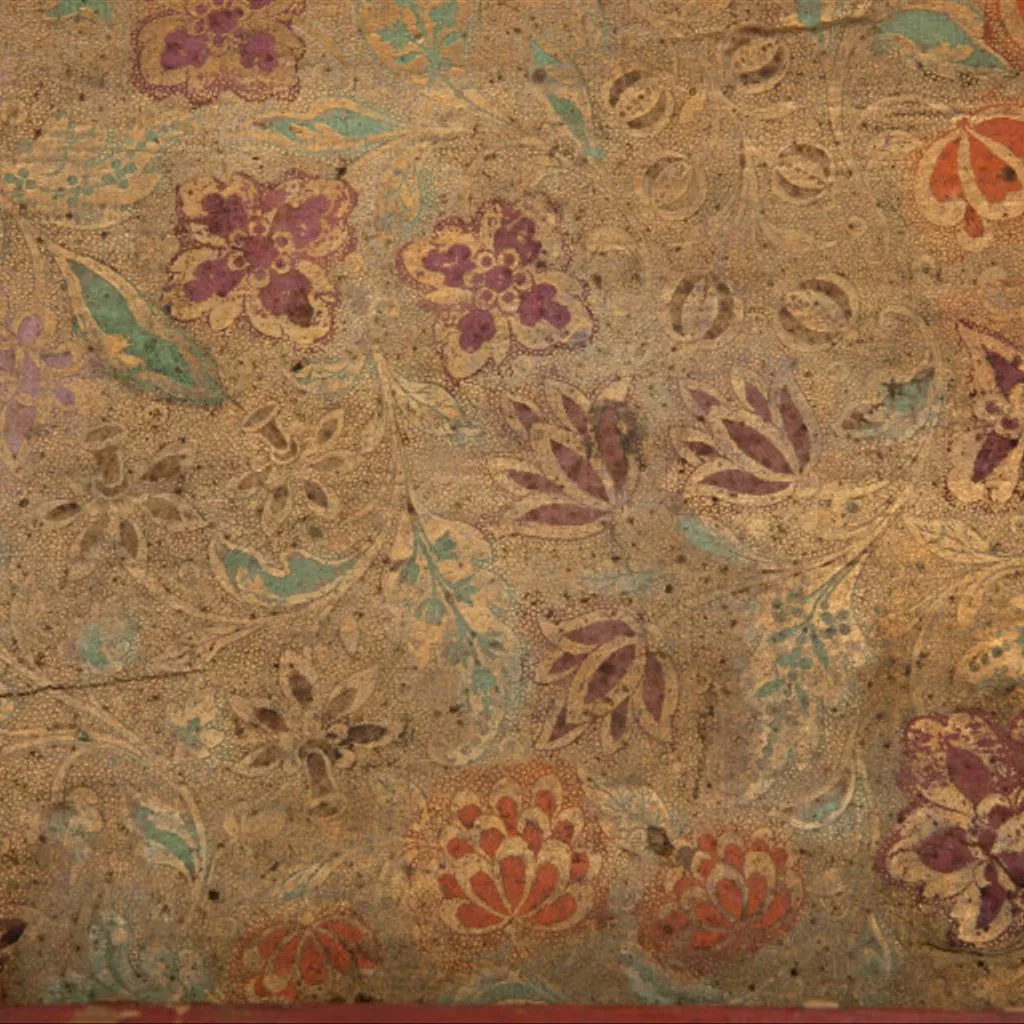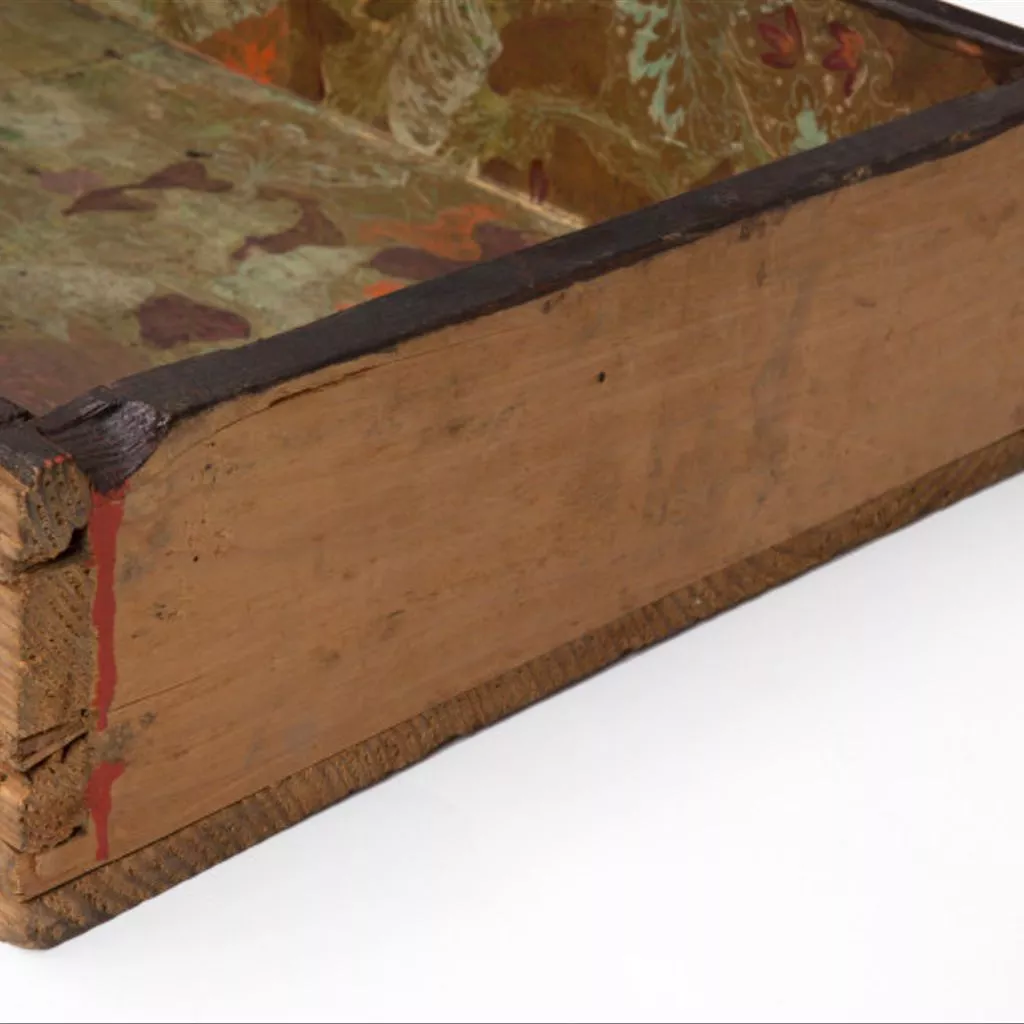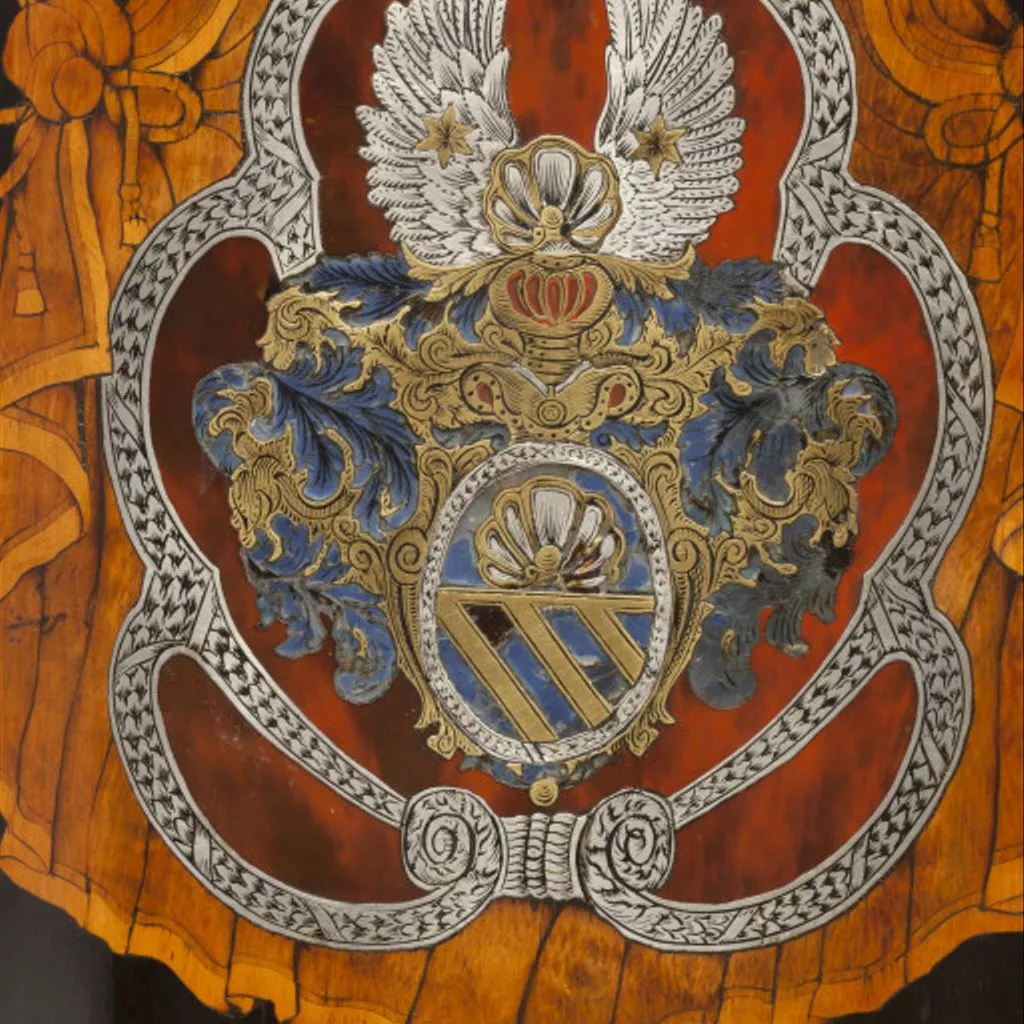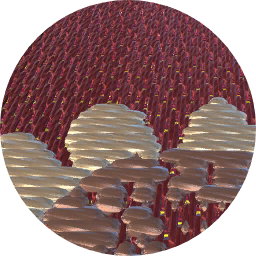Description
This cabinet is particularly interesting because the craftsmen who made it left a letter hidden inside, which gives a vivid description of the hard times 'when cabbage and corn were often the best food we could get hold of'. Such records of the personal life of craftsmen are very rare indeed.
Writing-cabinets were fashionable furnishings for a library or study. They implied that their owner was both wealthy and educated, a person who needed a special place to house his papers and personal treasures. In Würzburg in Germany, a cabinet of this kind was called a Trisur, a term relating to 'treasure'. In the southern German states they were often decorated with boulle marquetry, which uses both woods and metals in its veneers, and takes its name from André-Charles Boulle, the best-known cabinet maker to Louis XIV in Paris. On this cabinet, a simplified version of the boulle technique is used to create the owner's arms on the main doors, standing out against the more traditional wooden marquetry which shows flowers and scenes of interiors. The rather piecemeal design of the marquetry may have been the result of young craftsmen wishing to demonstrate that they could undertake a variety of work, from floral marquetry and scenes of interiors, to marquetry of birds, and the use of metals and other materials such as horn.
Writing cabinet(called in Würzburg a trisur) of bureau form, with cupboard above, veneered in walnut and other woods, with turtle shell, horn, pewter, brass and ivory, the marquetry including the date, 1716 and the arms and cypher of Jacob Gallus von Hohlach (1665-1724). Made in Würzburg, 1716 by Jacob Arend of Koblenz and Johannes Wittalm of Vienna, working for Servatius Arend, the court cabinet-maker in Würzburg.
Such writing cabints, of English form, became signifiers of the owner's status and education. They often appeared in portraits to suggest the education and wisdom of those in authority. The main flap is high and not easily suited to writing but the two side flaps may have been used by secretaries, standing to take dictation.
Writing cabinet, apparently in three sections (actually two), veneered in walnut, with marquetry of turtle shell, horn, brass, pewter, ivory and various woods, including snakewood, on a carcase of pine, the drawers lined with embossed gilded and colour-printed paper; mounts of lacquered brass. The cabinet takes the form of an English bureau with an integral cupboard above. The cabinet is inlaid with the date 1716 in pewter on the frieze and inside the writing flap is inlaid the cyper of Jacob Gallus von Hohlach (1665-1724), whose arms appear in the marquetry of the upper doors.
Design
The cabinet appears to be in three sections, with a central, sloping, flap-fronted writing compartment extending wider than the upper and lower cupboards, each accessed by two doors.The lower cupboard is buttressed on each side by a pair of stepped, S-scrolled consoles that support the outer drawers on each side, just below the writing compartment. This compartment is in three sections, with smaller flaps on the sides as well as the front. The cupboard doors of the upper tier are flanked by a bank of four drawers on either side, the topmost drawers stepping inwards with scrolling consoles at the outer ends. A frieze of two drawers forms a cresting to the cupboard.
The surface is decorated all over with marquetry of burr walnut, sycamore, boxwood, tulipwood ebonized and stained woods, and with pewter, brass, turtle shell, horn and ivory. On the inside of the main flap the marquetry of the cypher in pewter is laid into a ground of snakewood. The two doors of the upper cupboard show, in marquetry on a turtle shell ground, the arms of von Hohlach (see below) The drawers are lined with two patterns of embossed, coloured and gilded paper. The cupboards and the side writing compartments are lined with red watered silk, in the side compartments showing the embossed paper surviving underneath.
Lower Section
The lower section is raised on a shaped plinth, veneered in walnut and set with ebonized mouldings top and bottom. The centre of this plinth is recessed, below the two doors of shaped section, which open to reveal a cupboard with a single shelf and a full-width drawer at the top. Framing panels to either side of the cupboard doors follow a hollow quadrant plan, leading to the side panels, against which are set the double console brackets at each side. The quadrant panels rise only three-quarters of the height of the cupboard doors. Above them, the remaining height of the doors is occupied by a drawer with a shaped front on each side, running over the double balusters. The top edge of the lower cupboard section is moulded and ebonized.
The panels on the doors, the quadrant panels, the shaped drawers and shaped panels at the drawer height on the sides, are outlined with bands of ebonized wood set with continuous bands of ornament in light-coloured sycamore (upright anthemion and formal foliage), suggesting similar banding on boulle marquetry. The grounds of all the panels except the doors are veneered with burr walnut, inlaid with naturalistic flowers. The doors are inlaid with interior scenes (mirrored on the two panels), suggesting a theatre set with a single door, a tripod table in the foreground with a top of alternate dark and light squares, all enclosed in a strapwork border, from which hangs a striped rope on which sits a parrot and from which hangs a bunch of flowers. These panels are an odd mixture of elements. They appear to have been designed to show all the aspects of marquetry in which the makers had experience - perspective, flowers, birds and textiles.
An additional element is fixed to the front of the right-hand door, to cover the joining of the doors. The front face of this is set with dark/light marquetry of a repeating design. The panels on the sides of the cabinet are veneered with burr walnut, the edges cross-banded outside an octagonal framing in ebonized wood, the walnut in the centre book-matched. The drawers and doors are set with small, shaped lockplates in lacquered brass.
Four carved consoles, two at either side, are set under the drawer level of the lower section. These are not veneered but are grained to imitate walnut, the sides ebonized and the centre of each outer face ebonized and stencilled with hanging husks in gilding. Two of the consoles (those currently at the front of the cabinet) show notched carving on one side each and it is possible that two are later than 1716 in date.
The drawer at the top of the cupboard has a front that is shaped in plan, veneered in burr walnut and cross-banded in tulipwood with stringing in a red hardwood, and and outer framing of ebonized wood. The main panel of walnut shows a highly visible join of serpentine form.
Writing compartment
The upper part of the lower tier is composed of three writing compartments, the two side ones set at right angles to the main compartment. The hinged flaps of these, and the stepped panels at the front corners, are outlined with versions of the repeating patterns in light and ebonized wood, surrounding grounds of burr walnut. On the flaps only these bandings surround panels of burr walnut, outlined with tulipwood cross-banding, and set wtih floral marquetry in naturalistically stained woods (now faded), including tulips, roses and rosebuds and carnations, and with parrots and insects and butterflies, the antennae of these in pewter. The ledges in front of the side flaps show flowers and butterflies, also with antennae in pewter. The two side compartments were originally lined with stamped, printed paper, now covered with watered red silk over panels of cardboard. Each is set with a steel lock with double bolts, spring locks with a single throw.
The main compartment is highly decorated within. The flap and the base panel just behind it are each trapezoidal in shape and mirror each other in design, providing a frame for the owner's cypher, set in engraved pewter in a ground of snakewood, set with the grain running front to back, within bands of ornament in light and ebonized wood showing three-lobed motifs taken from boulle marquetry, in two patterns and edged with cross-banding in tulipwood and stringing in light and dark woods. The cypher, with calligraphic flourishes at either end on each line, is composed of addorsed pairs of letters forming monograms, together reading:
J E A L U S
J A C O B
for Gallus Jacob. The writing compartment is flanked at either side by two drawers. The recess, the drawer fronts and the triangular cheeks of the writing compartment are veneered in burr walnut (two panels in the recess), cross-banded with tulipwood and with two colour stringing. The sides and framing of the nest are cross-banded in tulipwood. The drawer fronts are set with small, plain-turned knobs in brass. The drawers are lined with stamped gilded paper.
If you remove the lower right drawer the floor of the compartment can be removed at the front as a single block of pine, revealing a recess under the back half of the floor. It is assumed that this is where the letter from the makers (see below) was found. A similar arrangement is visible under the lower left drawer but, although it is clear that strenuous efforts had been made to lift it before the cabinet came to the Museum, it has not proved possible to remove it safely.
Upper Section
The upper section shows two cupboard doors flanked by a bank of three drawers on each side, with similar dark/light framing bands of marquetry, cross-banding and floral marquetry set against burr walnut. Above these, on each side, is a smaller drawer with similar decoration, buttressed by a rounded section veneered with an inlaid scroll in ebonized wood and crested by a shaped panel inlaid in pewter with the date, '17' on the left (PR) panel and '16' on the right (PL) panel. Above this a deep, ebonized moulding forms a cornice, above which is set a shallow attic section, of serpentine outline, set with a single drawer, its front veneered as two panels with a design showing a balustraded gallery, beyond which a wooden-framed back wall and a beamed ceiling are visible, as if viewed from below. The drawers of the upper section are each set with brass drop handles in the form of acorns and oak leaves, against a six-point star backplate.
The marquetry on each main door shows, within formal dark/light marquetry bandings, a ground of burr walnut, set with a central ebony-veneered panel. A lower shaped compartment on each is set with marquetry of flowers in a vase, the marquetry with highlights in ivory. The upper compartment on each door is set with an armorial panel beneath an upholstered canopy in light wood, with drapery running down behind the arms. On the left side are the arms of von Hohlach: 'Per fess, in chief azure an escallop argent, and in base azure three bendelets or [a divided blue shield with a scallop shell above, and below three gold bars]', under the crest 'An escallop between a pair of wings joined in vol azure, each charged with a mullet or' [a scallop shell between a pair of splayed wings in blue, each set with a gold star] , against a mantling 'argent and azure' [an upper drapery in silver and blue]. These are the arms that were granted to von Hohlach in 1717. On the right side the same cresting and mantling provides a frame for the mirror monogram 'GJ' beneath a coronet.
The sides of the upper section are each set with three panels showing floral marquetry against a ground of burr walnut, outlined with bands of repeating ornament in dark and light woods. Above, the side of console scrolls are veneered in burr walnut, outlined with ebonized bandings. The stepped panels of the attic section at each side are similarly veneered, with a central long panel on each side showing a continuation of the balustrade of the front, with parrots perched on it.
Inside the central door, the cupboard is set with a central recess lined with red watered silk. it is set with two pairs of shelf supports and a single shelf, all covered in the same red silk. The cupboard is flanked by a bank of five drawers on each side, with a single, wider drawer below the central recess. The drawer fronts are veneered in burr walnut, cross-banded with walnut, with an outer frame of ebonized wood. The brass drawer handles are of the same pattern as on the external drawers. The front of the drawer framing is set with cross-banded walnut.
The locking of all visible drawers in the top section is controlled by one lock on each side, which throws a single, long, steel bolt. The drawers in the attic section are controlled by another single lock.
The lining papers to the drawers
The drawers and the side writing compartments are lined with decorative papers, in four different patterns embossed and printed with bronze powders and with coloured block prints of flowers and leaves. The disposition of the papers does not seem to follow any particular pattern. These papers are of the kind first made in Augsburg and Southern Germany, which later became used throughout Europe. None of the drawers are large enough to use a single sheet whole, so the dimensions of the sheets cannot be checked and none carry a maker’s name. Such papers were called ‘bronze-varnished papers’ or ‘brocade papers’. Those with an embossed ground were a recognized type, known as ‘spotted or stippled brocade papers’. Some of the interior drawers are additionally lined inside the base only with a plain red paper, presumably added in the 1840s, at the same time as the silk lining of the side compartments and the upper cupboard was done.
Paper 1
This is the most commonly used. It is printed in a bronze powder with a spotted, embossed ground and embossed outlines of stems, leaves and flowers in gold powder around unprinted areas. The flower heads, groups of small flowers, and foliage areas, are over-printed with blocks of green, scarlet, pink, yellow or crimson. These do not cover the printed designs with any precision. One flower type has a trumpet centre, similar to a daffodil. This paper is used in drawers :3 to :10; :12; :26; :34 and in the right (PL) writing compartment
Paper 2
The ground is not stippled but printed with bronze powder, over a white ground that is printed with blotchy patches of several shades of pinky purple, an orangey red, yellow and pink. Recognizable flowers include fritillary, tudor-type roses and daffodils, with poppy seed heads and bunches of grapes. Paper 2 is used in drawers:17 to :18; :24; :27 to :32; 36-:37.
Paper 3
This shows a stippled ground printed in bronze powder over a pale green ground, with leaf and flower shapes embossed and showing as a pale green. Recognizable flowers include fritillary, pinks or carnations and turk’s head lilies.
Paper 4
This shows no stippling of the ground, which appears green overall, with a design of complex, acanthus-like leaves and small chutes of flowers embossed and printed in bronze powder. The paper is over-printed with irregular blocks of vermilion, pale pink and reddish purple, highlighting groups of flowers, or leaf shapes.
Construction
The carcase is of softwood, the construction of quite rough quality, using thick sections of wood, even for the small drawers. The lower section is built in two piece (cupboard and writing compartment) that are glued (and probably screwed) together. The cupboard section is built between a base that forms the top of the plinth, and a top board that forms the top of the cupboard and of the compartments for the flanking drawers. The plinth top is raised on shaped, vertically set boards, glued and pinned together to follow the curving outline, and reinforced inside with large blocks of softwood, glued and pinned on, and with two stout board, set vertically, that run front to back under the outer sides of the cupboard above. The lower edge of this plinth is raised further with two shallow sections of ebonized wood under each side (to the area outside the cupboard doors) and two short, shallow blocks of ebonized wood at the back edge of the sides.
The sides of the cupboard are jointed to the two horizontal boards with running dovetails (visible at the back at plinth level). On each side an additional, outer side runs only between the plinth top and the underside of the drawer compartment and is tenoned into both. The section between the inner and the outer sides at the front are filled on each side with a board that is curving in plan and presumably is set in grooves in the plinth and the undersides of the drawer compartments. The drawer recesses at frieze level are built with sides and bases dovetailed together and presumably tenoned (or set in continuous grooves) into the outer faces of the sides of the cupboards and into the main top of the lower section. The drawer sections are supported by the free-standing carved consoles, which are are dowelled into the plinth and the underside of the drawer compartments.
The writing compartment is separately constructed, between a smaller base-board, conforming to the top of the cupboard, and a smaller still top board, set behind the sloping flaps to the writing compartments. There is a shallow gap between the top of the cupboard and the base of the writing compartment that is filled on the front and sides with a concave moulding. This serves to give space for the writing flaps to hinge downwards. The base of the compartment must be held up on an open framework or series of cross rails. These are not generally visible but part of such a structure is visible in the hidden compartment (see below). The structure of the writing section appears to be built up around two sides, running front to back, forming the partititions between the main writing compartment and the two side ones. These are presumably tenoned to the base and top. On the outer front corners, the solid, canted sections must be built up against these but their jointing to the base is unclear and they may be simply glued onto it. Inset from the sides are two further boards running from the back of the case to a point just behind the lettered panel that mirrors the lettered writing flap. These form the inner sides of drawer compartments, each set with a single dustboard tenoned into the sides of the compartments or running in rebates cut into them. The bases of the lower compartments on each side are cut into two sections. The front board of the right-hand compartment can be lifted to give access to a very shallow compartment between the base of the writing compartment and the top of the cupboard (the two separated by blocks). It was here that the letter was discovered. In the left hand compartment the board is glued in place and it has not proved possible to remove it without damage. Within the two flanking banks of drawers is a recessed area, set at the back with a nest of six drawers, four over two. The framework for this is not built as a separate unit but set within the larger framework of the outer drawers, with a single dustboard and central division going through both levels, and shallow drawer divisions further dividing the upper level, all these probably jointed by rebating one element into another. The main writing flap may be of panelled or cleated construction but there is no visible evidence for its construction. The side flaps are cut from a single board, with additional mouldings added to form the rounded section along the hinge line. The grain of these boards runs front-to-back and the endgrain is visible on the back edges.
The upper section is built in two section also, a cupboard section flanked by drawers, and a separate box section above, now attached with glue and pins. The two verticals forming the main cupboard sections run between a shaped base board and a smaller, shaped top board. They may be attached with tenons or with running dovetails. To either side are a bank of three drawers, the sides of the compartment dovetailed to the tops which are jointed to the outer face of the cupboard sides with tenons or running dovetails. The two two dustboards run in rebates cut on the inner faces of the two upright sections. Above these drawers on each side a narrow drawer is housed in a separate compartment, presumably constructed in a similar manner. These uprights are buttressed by large elements of wood, the grain running front to back, which carry the veneered scrolls that appear to flank the drawers. The cupboard is fitted with a complete inset nest of 10 drawers set in two banks of 5, flanking a central recess (fitted with two pairs of battens to support shelves, only one of which is now present), below which is a wider drawer. This nest is composed of an outer box structure (presumably dovetailed), set with a frame of two verticals, between which are set the dustboards for the drawers and the base of the recess, all of which appear to be cut into v-shaped grooves on the verticals and fitted from the back.
Above this, the topmost section contains two shallow drawers. The framework for the drawers appears to be constructed as a shallow box (presumably dovetailed), onto which are glued sections of timber and mouldings to create its serpentine outline. The drawers have serpentine fronts, cut in the solid.
The backboards, in pine, with the grain running horizontally, are inset within rebates cut in the sides at each level. All appear to be original (though re-set at different times) but only the backboard to the upper, cupboard section is cleated.
Writing Cabinet
1716
Writing cabinets in libraries or studies were status symbols for wealthy and noble men. This cabinet has a complex form and is clad in fashionable marquetry. The decoration incorporates the arms of its powerful owner, Gallus Jacob, finance minister to the Prince Bishop of Würzburg. The craftsmen who made the cabinet left a document inside it that gives a vivid description of the turbulent times in which they were working.
Germany (Würzburg)
Made by Jacob Arend and Johannes Wittalm, in the workshop of Servatius Arend
Pine veneered with walnut, ebony and ebonised wood; marquetry in turtle shell, horn, brass, pewter, ivory and several woods; copper alloy mounts [09.12.2015]
[Label text by Peter Thornton]
Cabinet
German (Wurzburg): dated 1716
Pine, veneered with marquetry of various woods with tortoiseshell and pewter. Drawers lined with multi-coloured embossed paper
The arms are those of von Holach, the title taken by Gallus Jacob, whose name is inlaid on the writing leaf: he was a powerful official in the service of Johann Philip von Greiffenclau, Prince Bishop of Wurzburg. On the latter's death, Gallus Jacob fell from favour: he was removed from his post and his goods were confiscated.
In 1967 a piece of paper was discovered behind a panel showing that the cabinet had been made in 1716 by Jacob Arend of Koblenz and Johannes Wittalm of Vienna, working for the court cabinet-maker at Wurzburg, Servatius Arend. [1975]














































































